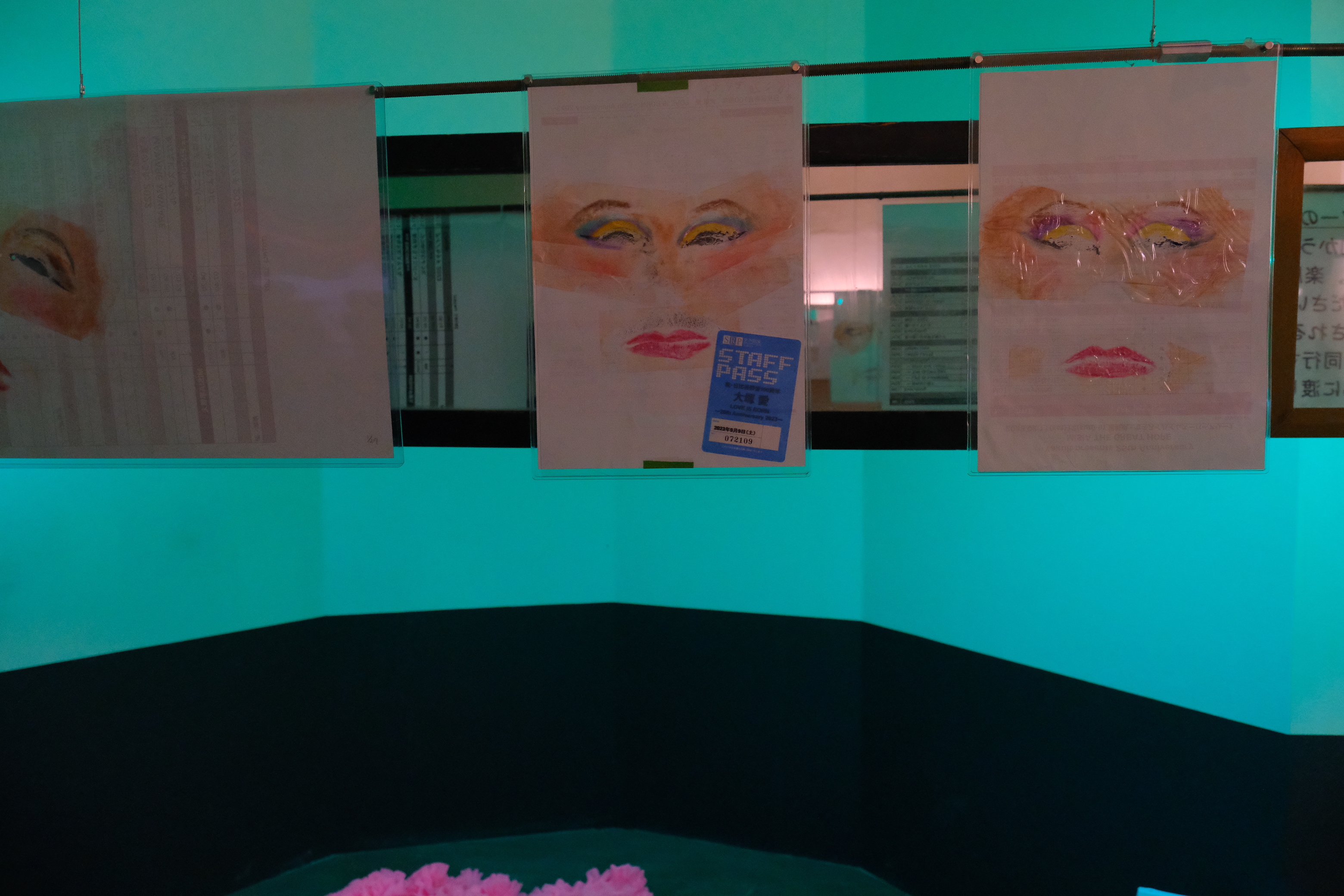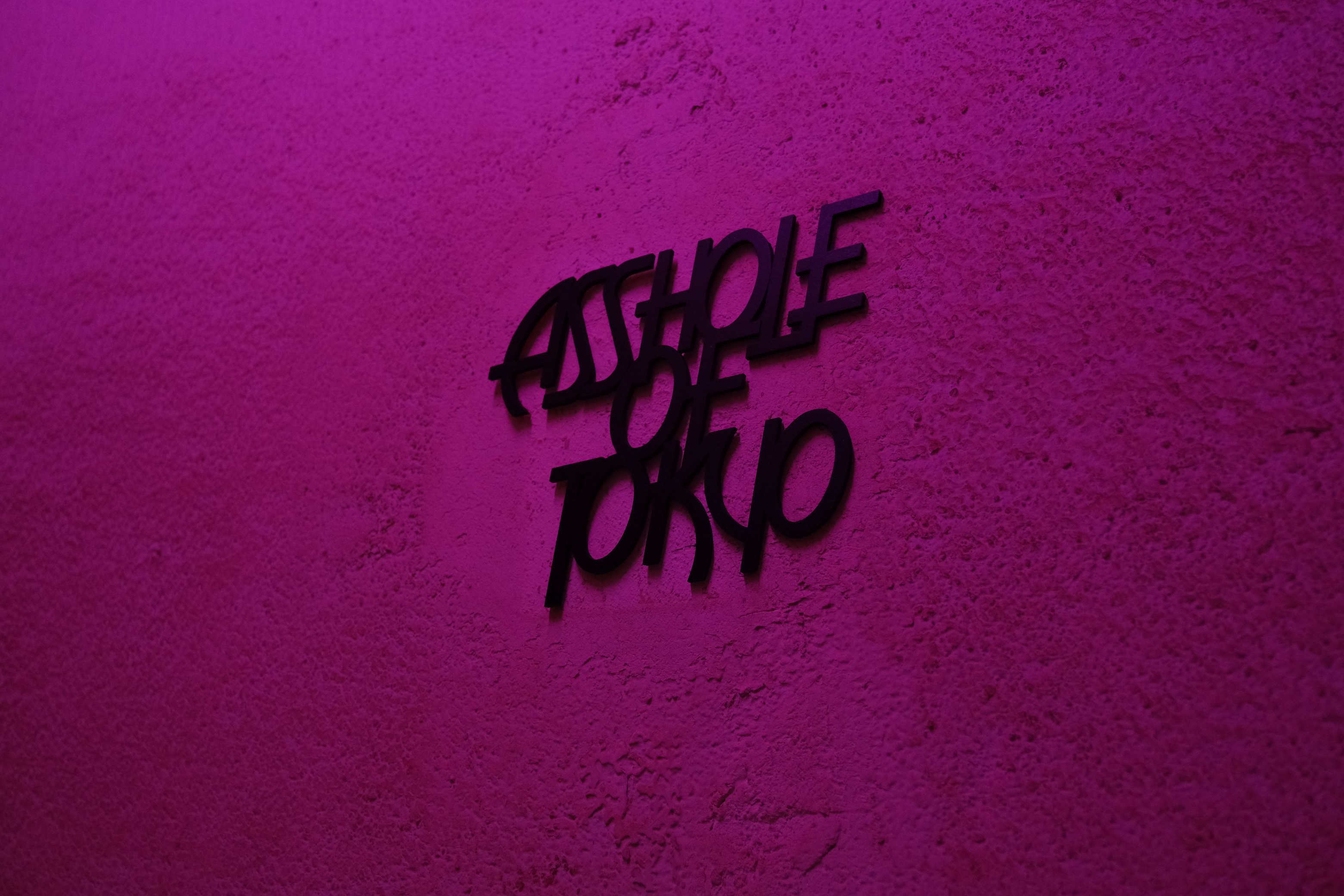- ---
Project Index -
BENTEN 2024BENTEN 2024 2024
ナラッキーNa-Lucky 2023
DOBUROKGEOLLIDOBUROKGEOLLI 2022
いつのことだか思いだしてごらんいつのことだか思いだしてごらん 2022
改名Name Change 2022
くらいんぐみゅーじあむCrying Museum 2022
SUNSUN 2022
はい、こんにちは Hello There 2020
May, 2020, TokyoMay, 2020, Tokyo 2020
A Drunk PandemicA Drunk Pandemic 2019
にんげんレストランNingen restaurant 2018
道Street 2017-
The other side 2017
Scrap & Build 2 2017
Scrap & Build 2016
Don't Follow The Wind initiated by Chim↑Pom 2015-
堪え難きを耐え↑忍び難きを忍ぶ10th ANNIVERSARY EXHIBITION 2015
金三昧KANE-ZANMAI 2014-
パラドックスPARADOX 2014
LOVE IS OVER 2014
マッドエリイMAD ELLIE 2013-
GARBAGE 2012-
PAVILION 2012-
REAL TIMES 2011
パズルPUZZLE 2011,2014-
IMAGINEIMAGINE 2010
BLACK OF DEATH 2008,2013
広島HIROSHIMA 2008-
日本のアートは10年おくれている 世界のアートは7,8年おくれているJAPANESE ART IS 10 YEARS BEHIND, AND ART OF THE WORLD IS 7 OR 8 YEARS BEHIND. 2008
友情か友喰いか友倒れかBecoming Friends, Eating Each Other or Falling Down Together 2008
TPA 2007
サンキューセレブプロジェクト・アイムボカンTHANK YOU CELEB PROJECT "I'M BOKAN" 2007
ともだちTOMODACHI 2007
オレオレORE-ORE 2007
エロキテルEROKITEL 2007-
スーパーラットSUPER RAT 2006-
BODY 2005-
- ---
Overview open -
歌舞伎町・王城ビルでビルと共同で開催したプロジェクト。テーマを「奈落」とし、歌舞伎超祭や歌舞伎役者・尾上右近、多くのミュージシャンらとのコラボレーションで作品を制作。それらが観客や演者らに利用・介入されることによって移り変わる、パフォーマティブな展覧会となった。舞台の王城ビルは、街の守護神である歌舞伎町弁財天(歌舞伎町公園)に隣接する町古参の建物である。業態を変化させながら2020年3月まで自主経営が続けられたが、コロナ禍に閉店。その後任意団体「歌舞伎町アートセンター構想委員会」が立ち上がり、第一弾として開催されたのが本プロジェクトである。ビルの中で約30年間閉ざされていた4フロア分の吹き抜けに常設設置したサイトスペシフィック・インスタレーション「奈落」のお披露目に紐付き、展示やパフォーマンス、音楽、レストランやショップなどを独自に展開。1カ月限定の「Chim↑Pom from Smappa!Groupによる美術館」のような総合文化施設が仮設された。
会期: 2023年9月2日(土)〜10月15日(日) 火曜日休館
会場: 王城ビル (歌舞伎町1132)
企画: 歌舞伎町アートセンター構想委員会、Chim↑Pom from Smappa!Group
主催: 大星商事株式会社、Chim↑Pom from Smappa!Group、Smappa!Group
共催: ANOMALY
協賛: 東急歌舞伎町タワー 、元気キッズ、エイベックス・クリエイター・エージェンシー株式会社
後援: 新宿区、歌舞伎町商店街振興組合、一般社団法人ナイトタイムエコノミー推進協議会
協力: 尾上右近事務所、OIP、無人島プロダクション、WHITEHOUSE、studio ghost、浅草公会堂
スペシャルサンクス: 尾上右近
https://www.hellonaraku.com/
A project held at Kabukicho’s Ohjo Building in collaboration with the building. The theme was “naraku” (the end) and works were created together with the Kabukicho Festival, Kabuki actor Ukon Onoe, and many musicians. The exhibition was a performative one in which the artworks transformed through the use of and intervention by the audience and performers. The Ohjo Building is an old structure adjacent to Kabukicho Benzaiten (Kabukicho Park), the guardian deity of the town. It continued to operate independently under various businesses until March 2020, but closed in the wake of the pandemic. After that, a voluntary organization, the Kabukicho Art Center Concept Committee, was formed, and this project became its inaugural work. Tied to the unveiling of the site-specific installation "Naraku" in the four-floor atrium, which had been closed for 30 years, the project included an exhibition, performances, music, a restaurant, and a store. Similar to a one-month-only museum by Chim↑Pom from Smappa!Group, a multifaceted cultural facility was temporarily set up.
Dates: Saturday, September 2 - Sunday, October 15 (Closed on Tuesdays)
Location: Ohjo Building (1-13-2 Kabukicho)
Organized by: Kabukicho Art Center Concept Committee, Chim↑Pom from Smappa!Group
Sponsored by: Taisei Shoji Co., Ltd., Chim↑Pom from Smappa!Group, Smappa!Group
Co-organizer: ANOMALY
Sponsor: TOKYUKABUKICHOTOWER, GenkiKids avex creator agency Inc.
Supported by: Shinjuku City, Kabukicho Shopping District Promotion Association, Night Time Economy Promotion Council
Cooperation: Ukon Onoe Office, OIP, Mujin-To Production, WHITEHOUSE, studio ghost, Asakusa Public Hall
Special Thanks: Ukon Onoe
https://www.hellonaraku.com/
- ---
Index open/close -
外Outside
全館All Floors
2階2nd Floor
4階4th Floor
5階以上5th Floor Rooftop
地下1階First lower level
1階First floor
- ---
外Outside open/close -
1. 歌舞伎町公園
沼を埋め立てた歴史から水にまつわる弁財天を祀る歌舞伎町の聖地。通称歌舞伎町弁財天。土地のルーツとして変わりゆく街並みの中でその姿をとどめ続け、歓楽街が育つ「湿った場所」の精神性をいまに伝える。
1. Kabukicho Park
A sacred place in Kabukicho dedicated to Benzaiten, a deity associated with water, due to the land being a reclaimed swamp. It is also known as Kabukicho Benzaiten. As the basis of the area, it continues to retain its appearance amid the ever-changing landscape, and represents the spirituality of the "damp place" that nurtures the entertainment district.

歌舞伎町公園Kabukicho Park
撮影:森田兼次Photo: Kenji Morita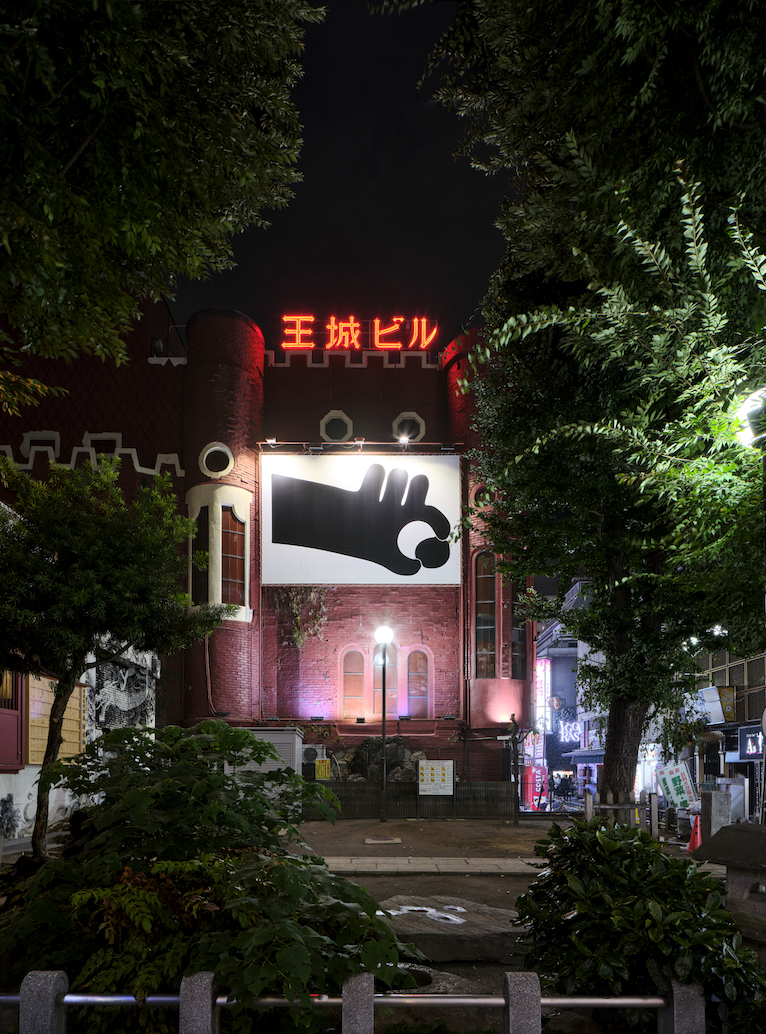
歌舞伎町公園Kabukicho Park
撮影:森田兼次Photo: Kenji Morita
2023
Chim↑Pom from Smappa!Group
ジェスモナイト、土、アクリルボックス、照明
制作協力: 渡辺志桜里、トモトシ
ジェスモナイトを流し込み模った、王城ビル裏口に残るネズミの古巣穴。
2. Nest (Naraku)
2023
Chim↑Pom from Smappa!Group
Jesmonite, soil, acrylic boxes, lights
Production Support: Shiori Watanabe, Tomotoshi
An old rat nest, which remains at the back entrance of the Ohjo Building, is casted using jesmonite.
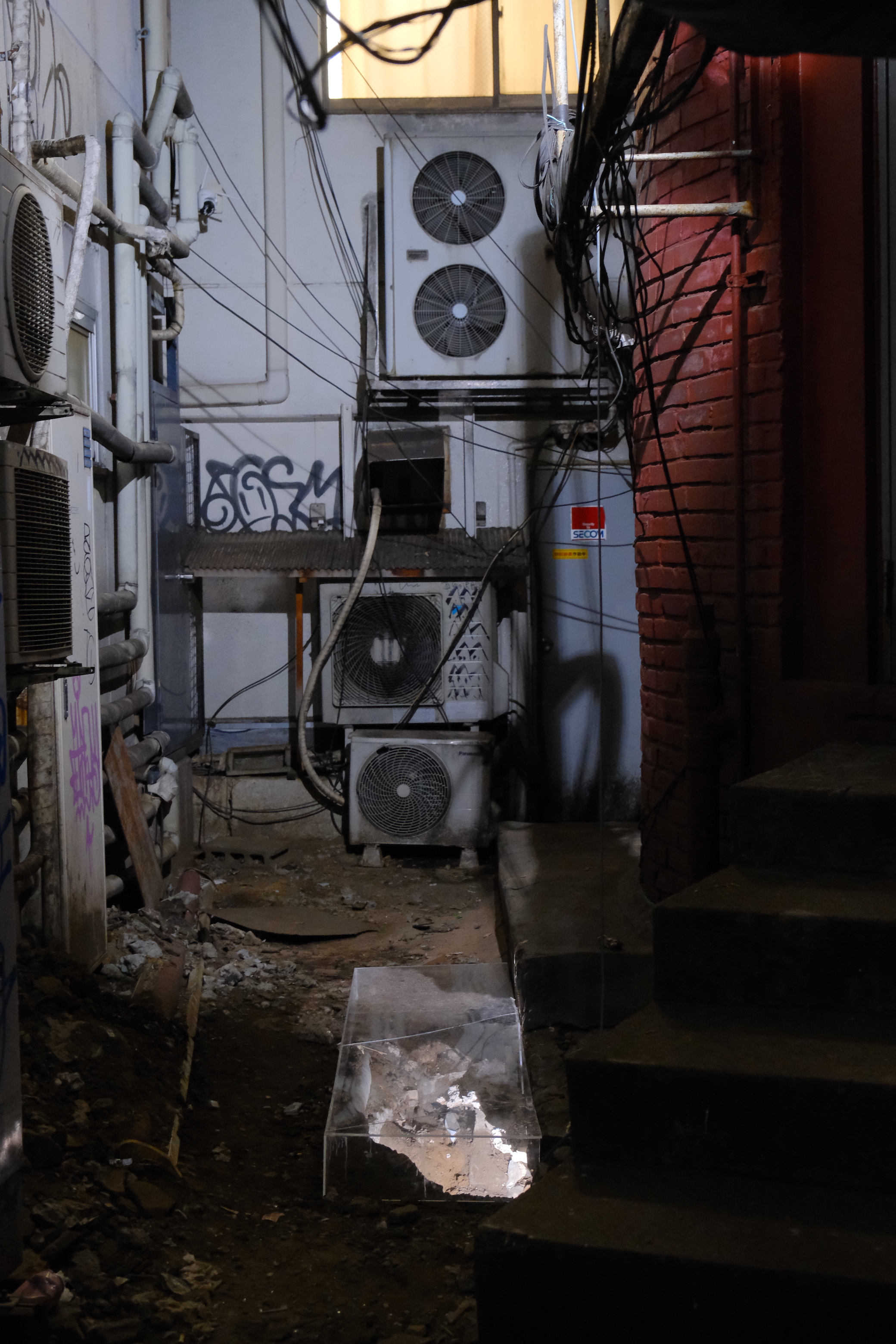
巣 (奈落)Nest (Naraku)
撮影:森田兼次Photo: Kenji Morita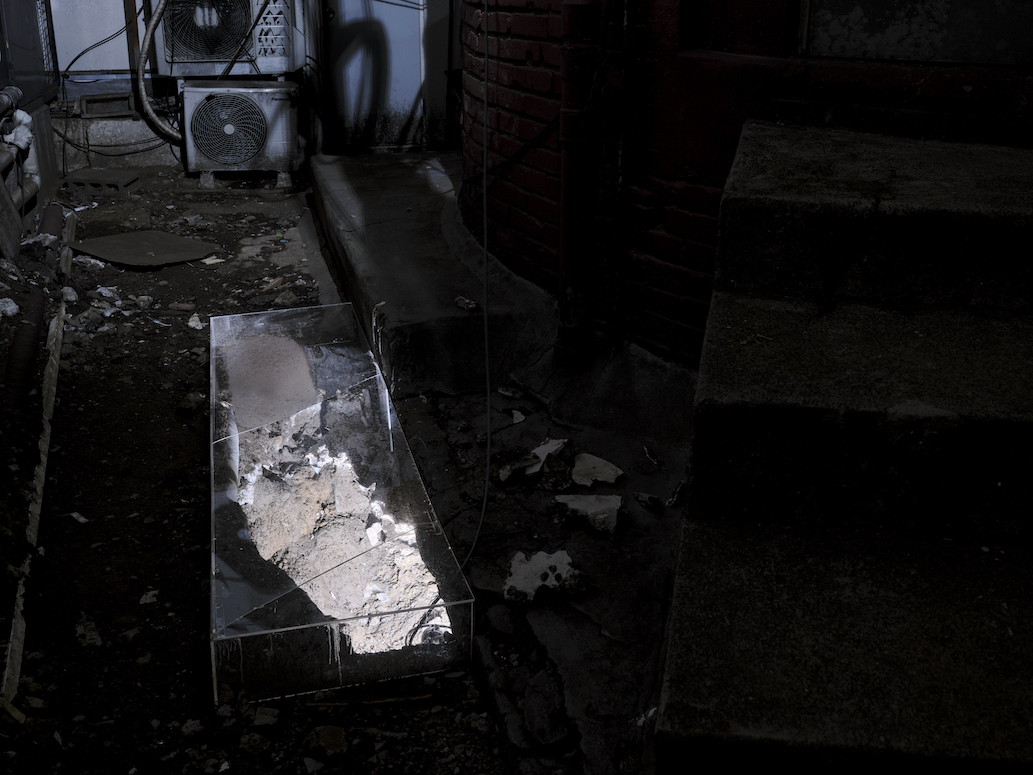
巣 (奈落)Nest (Naraku)
撮影:森田兼次Photo: Kenji Morita
巣 (奈落)Nest (Naraku)
撮影:森田兼次Photo: Kenji Morita
- ---
全館All Floors open/close -
ナラッキー
2023
Chim↑Pom from Smappa!Group
着ぐるみ、パフォーマンス
着ぐるみ制作: 西岡七歩子
Na-Lucky
2023
Chim↑Pom from Smappa!Group
Kigurumi costume, performance
Kigurumi made by Nahoko Nishioka
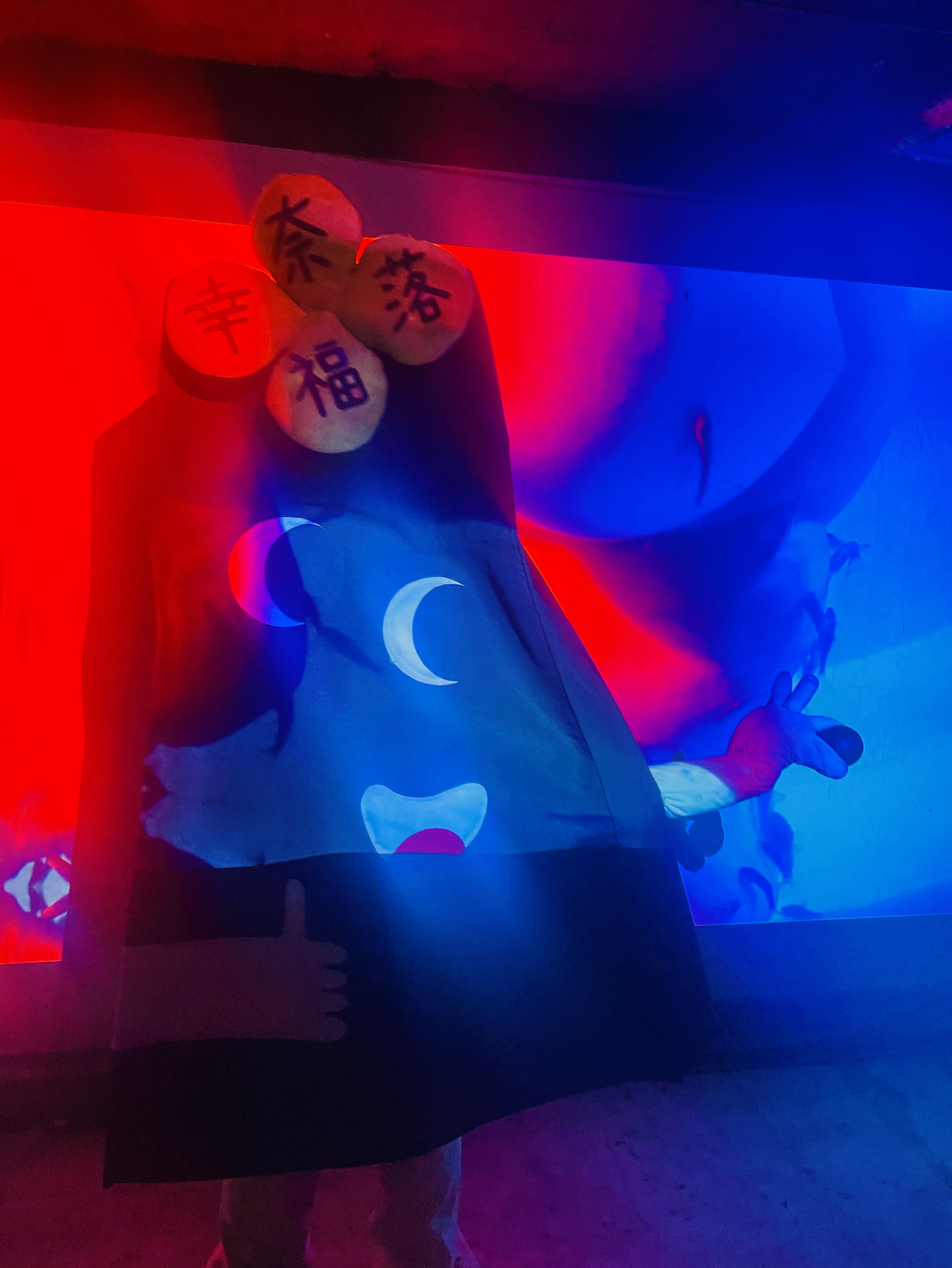
ナラッキーNa-Lucky

ナラッキーNa-Lucky
撮影:森田兼次Photo: Kenji Morita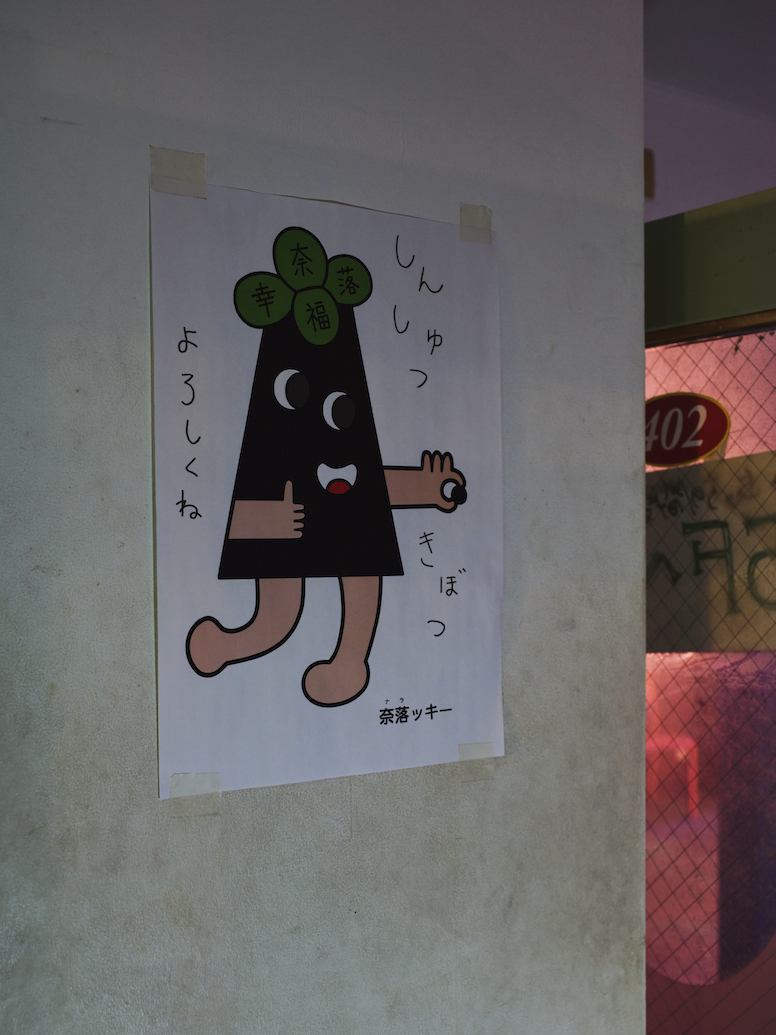
ナラッキーNa-Lucky
撮影:森田兼次Photo: Kenji Morita
- ---
2階2nd Floor open/close -
3. 奈落
2023
Chim↑Pom from Smappa!Group
サイトスペシフィック・インスタレーション
王城ビルの吹き抜け空間、スラブ、ワイヤー、サウンド、ミクストメディア
設計・制作: 東弘一郎 (あずま工房)
設計・構造計算: 瀧本信幸
協力: 周防貴之
音/演目: 尾上右近自主公演第七回「研の會」浅草公会堂「夏祭浪花鑑長町裏」「京鹿子娘道成寺〜山づくし」
音響:涌井智仁
防犯カメラ展開: トモトシ
歌舞伎町の名前が歌舞伎座誘致頓挫という戦後の都市計画に由来することに注目し、王城ビルで約30年間閉ざされてきた吹き抜け空間に「奈落」を設定。仏教用語で地獄を意味する「奈落」は、そこで働く人々がかつて「穴番」と呼ばれていたように、穴や沼のように仄暗く捉えられてきた。
本作では、空間に尾上右近の自主公演『研の會』による公演中の奈落で録音された歌舞伎公演の音を流し、カッティングした5階と屋上のスラブを「セリ」として上下に動かす。セリはサーチライトを搭載し、1時間に1回往復、夜になると上空に一筋の光を伸ばす。
さらに足元の2階の床(1階天井)も解体。閉鎖されていた「奈落」の概念を街と天へと上下左右に拡張する。
3. Naraku
Chim↑Pom from Smappa!Group
Site-specific installation
Atrium space of Ohjo Building, slabs, wires, sound, mixed media
Design and Production: Koichiro Azuma (Azuma Kobo)
Design and Structure Calculation: Nobuyuki Takimoto
Support: Takashi Suo
Sound/performance program: Self-organized performance by Ukon Onoe, 7th Ken no Kai, Asakusa Public Hall "Natsumatsuri Naniwa Kagami Nagamachiura no dan" "Kyoganoko Musume Doujouji until Yamazukushi"
Sound: Tomohito Wakui
Security Camera Development: Tomotoshi
Focusing on the fact that the name Kabukicho comes from a failed postwar city plan to attract the Kabuki-za Theater, Chim↑Pom from Smappa!Group sets a naraku in the atrium space of the Ohjo Building that had been closed for about 30 years.
The word naraku, which means hell in Buddhist terminology, has been associated with dark swamps and holes, as the people who work there were once called "anaban," or literally “hole guards.” In this work, the space is filled with the sound of a kabuki performance recorded in the naraku during Ken no Kai, a self-organized performance by Ukon Onoe, and the cut slabs on the fifth floor and the rooftop are moved up and down as a seri, or an elevator-type mechanism used to raise and lower a portion of a kabuki theater stage. The seri is equipped with searchlights, which go around once an hour and extend a ray of light towards the sky above. In addition, the second floor floor (or the first floor ceiling) is dismantled. The concept of a closed naraku is extended to all four directions toward the neighborhood and the sky.
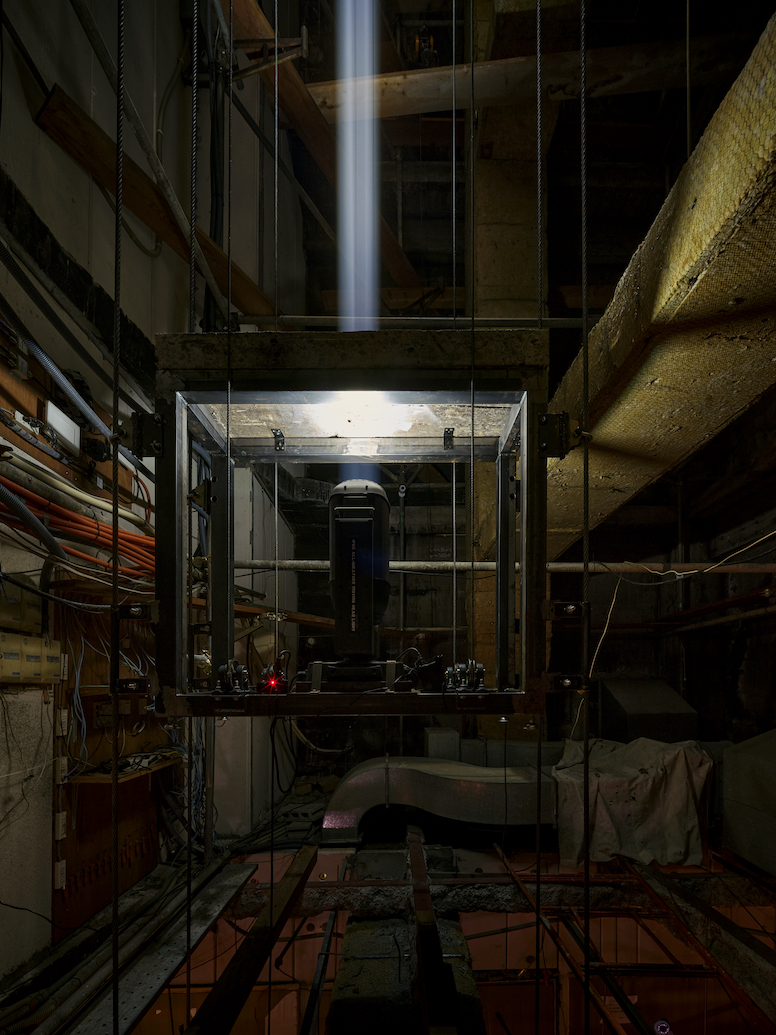
奈落Naraku
撮影:森田兼次Photo: Kenji Morita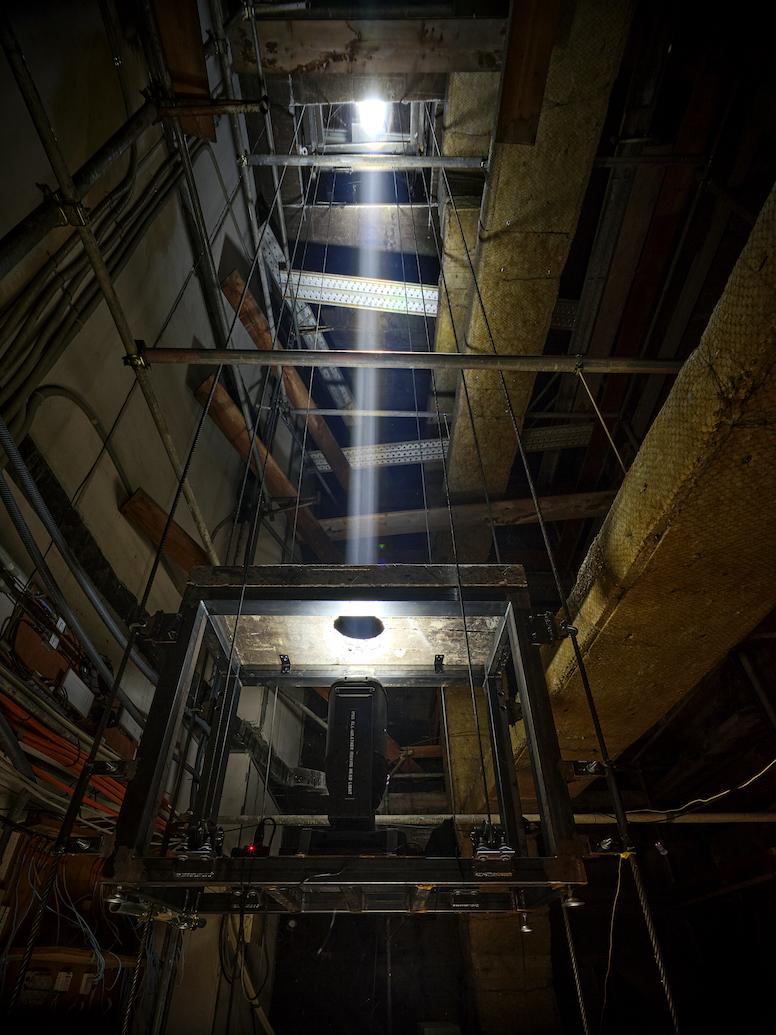
奈落Naraku
撮影:森田兼次Photo: Kenji Morita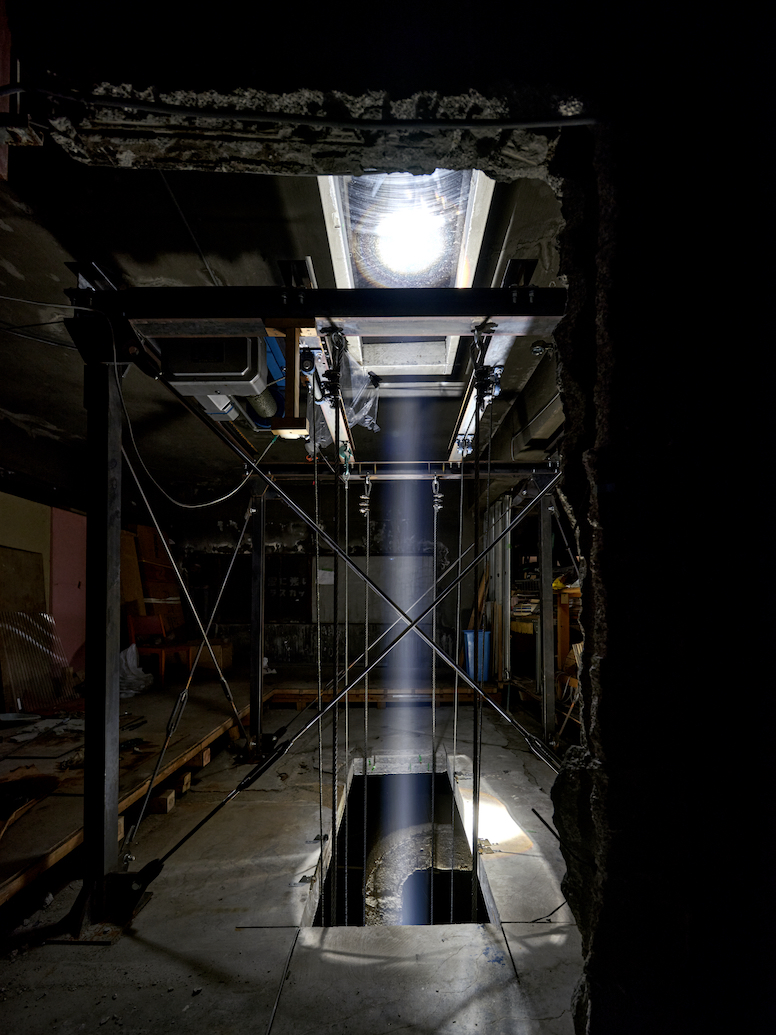
奈落Naraku
撮影:森田兼次Photo: Kenji Morita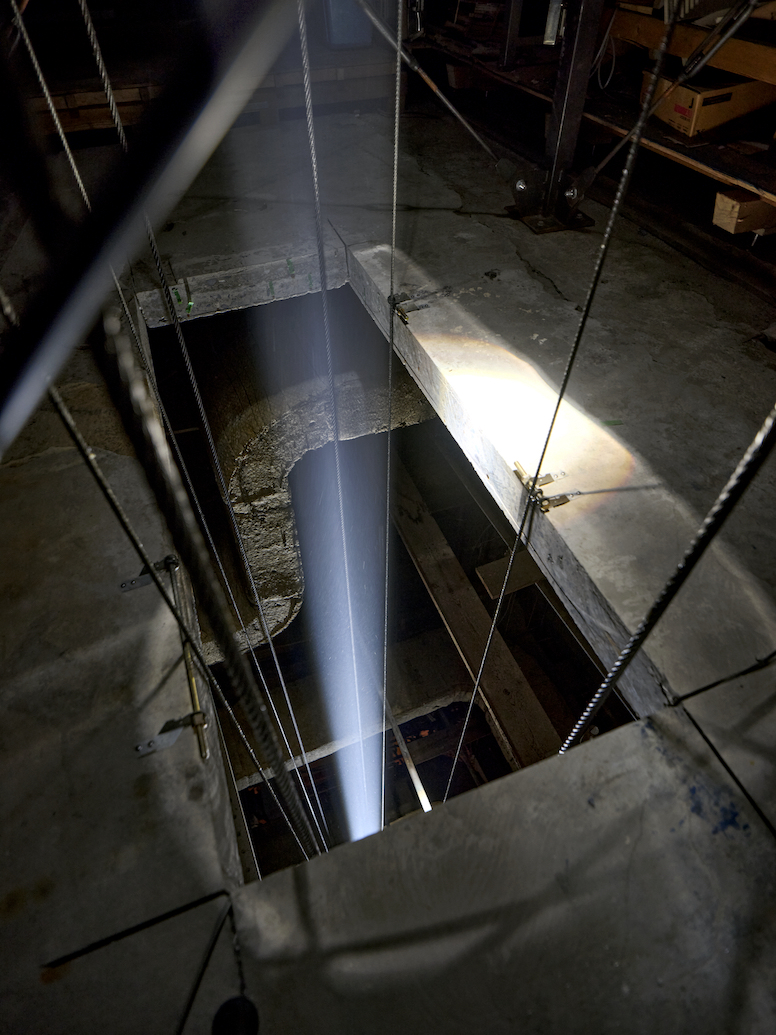
奈落Naraku
撮影:森田兼次Photo: Kenji Morita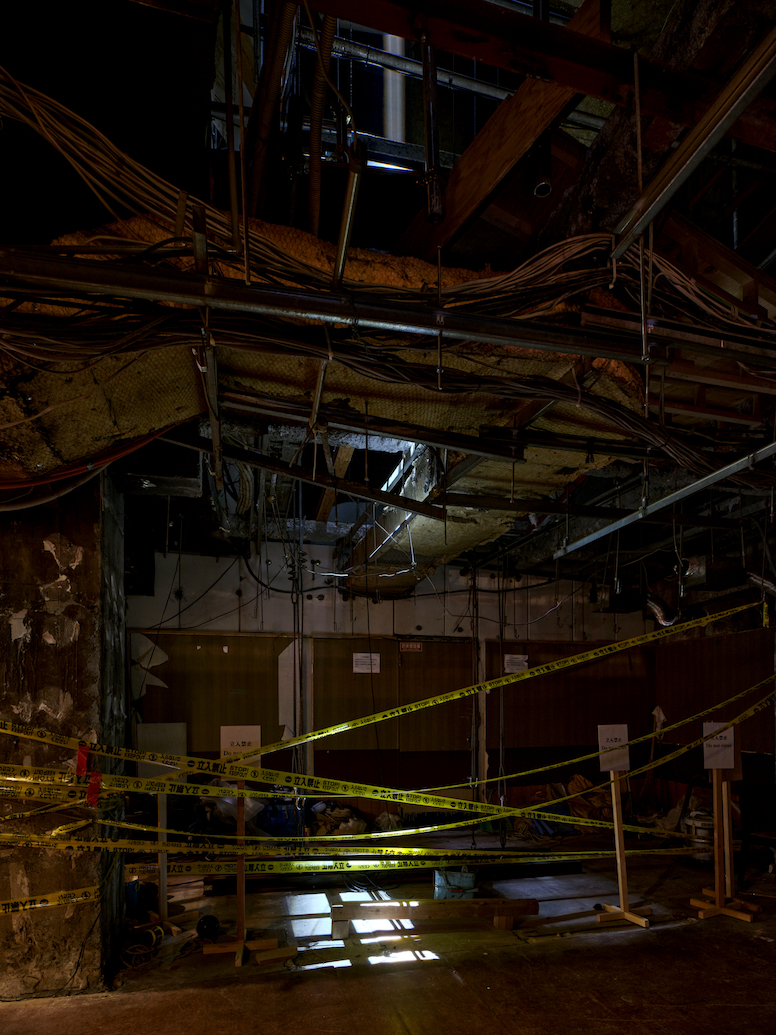
奈落Naraku
撮影:森田兼次Photo: Kenji Morita
今年3回目を迎える「歌舞伎超祭」とのコラボレーション。ドラァグクイーンやポールダンス、バーレスク、車椅子ダンサーなどをミックスした歌舞伎町独自のフェスである。その演者たちを迎え、「奈落」の中でのパフォーマンスを記録。前半は閉鎖空間の状態で、後半は吹き抜けの上下が解体されて街や空と繋がった状態で撮影。パフォーマー指定のカメラマンによるスチルをミックスし、スライドショーとすることで、彼ら・彼女らによって「奈落が制作されている(メイキング)」であることを強調する。また、パフォーマーの私物なども展示し、インスタレーション全体からエンターテイナーの生き様をドキュメントする。
ショウビジネスが体現してきた歌舞伎町の文化は、翻って、歌舞伎のルーツに接近するような逆転現象を生んできた。そもそも江戸時代の「二大悪所」は歌舞伎と遊郭であったと伝えられるほどに、歓楽街と芸能には強い関係がある。歌舞伎の祖である出雲阿国は茶屋遊びのパロディとして登場し、その流行を広めたのは遊郭での「女郎歌舞『妓』」であった。ともに演者が女性であったことから、勃興当時の歌舞伎の「き」は女へんの「妓」が使われていたと伝えられる。
また、阿国一座の男装と女装をルーツとする歌舞伎の芸風は、昨今議論される性のトランスの歴史にも独自の示唆を与えるはずだ。舞台を人々の世俗やクィア的なるものへと解放した歌舞伎の革命性は、だからこそ当時の道徳観においてさまざまな軋轢を生んだ。歌舞伎の成り立ちは、そのまま為政者による禁令との戦いの歴史であったと言えるだろう。
4. The Making of the Naraku (Section)
A collaboration with the third annual Kabukicho Festival. This festival is unique to Kabukicho, bringing together drag queens, pole dancers, burlesque and wheelchair dancers, and more. Chim↑Pom from Smappa!Group invites these performers and records their performances in the naraku. The first half of the film is shot when the naraku is closed, while the second half takes place in the atrium when the upper and lower sections are dismantled, connecting the space to the neighborhood and the sky. Still images by a photographer appointed by the performers are mixed in with a slideshow to emphasize that the naraku is "being created(made)" by them. The performers’ personal belongings are also displayed to document the entertainers' lifestyle through the installation as a whole. The culture of Kabukicho, embodied by show business, has, in turn, produced a kind of reverse culture that gets close to the roots of kabuki. To begin with, the entertainment districts (kanrakugai) and the art of entertainment (geinoh) have such strong ties that kabuki and brothels are said to have been the "two most evil places" during the Edo period.
Izumo-no-Okuni, the founder of kabuki, first appeared as a parody within teahouse entertainment, and it was the jorou kabuki (women singing and dancing) in the brothels that spread its popularity. Since the performers were women, it is said that the kanji character for "ki" in kabuki at the time of its emergence used the “woman” (女) radical(妓).
The kabuki art form, which has its roots in the crossdressing of the Okuni Ichiza troupe, may also provide unique insight into the history of gender transgression, the subject of much discussion in recent years. The revolutionary nature of kabuki, which liberated the stage to the realm of people’s secular and queer sensibilities, caused various tensions within the values of the time. It can be said that the origins of kabuki is a history of battles against the prohibition of the art form by the ruling class.
A. はじまり
2023
Chim↑Pom from Smappa!Group+松田修
ビデオインスタレーション
歌舞伎超祭のキャスティングを手掛けるOi-chanと友人であるエリイの会話を記録、エリイの口元に2人の声を重ねて再構成する。
「業界」では特殊なキャスティング・ディレクターとして知られるOichanだが、メディアへの露出は多くない。その謎めいた素顔に迫ることで、歌舞伎超祭とパフォーマーの特異性に入り込む導入とする。
【 - Below are the exhibited works for the section 4. 】
A. The Beginning
2023
Chim↑Pom from Smappa!Group + Osamu Matsuda
Video installation
A conversation between Oi-chan, who oversees casting for the Kabukicho Festival, and Ellie, who is friends with Oichan, is recorded and reconstructed by superimposing their voices onto Ellie’s mouth. Oi-chan is known in the industry as a unique casting director, but does not appear much in the media. Focusing on the mysterious persona of Oi-chan, the video introduces the special qualities of the Kabukicho Festival and its performers.
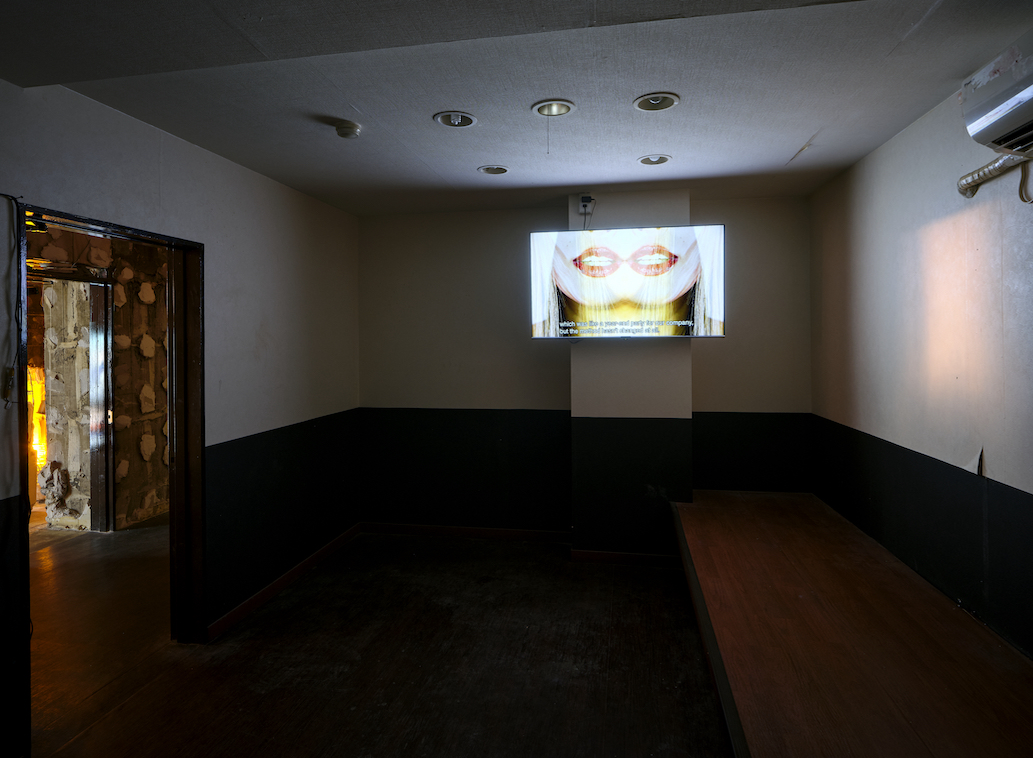
はじまりThe Beginning
撮影:森田兼次Photo: Kenji Morita
Video, 01:04:18 (duration)
B. MONDO, one of Japan’s pioneering drag queens, has been continuing gantaku, or face printing. This exhibition will be the first to feature MONDO's personal practice as an artwork. Unlike kabuki’s kumadori, which uses cloth as a support, makeup is peeled off and transferred onto transparent tape, which is pasted on the back of paper handouts found in dressing rooms. The work shows MONDO’s connection with MISIA, who has been featuring drag queens in the mainstream scene for many years.
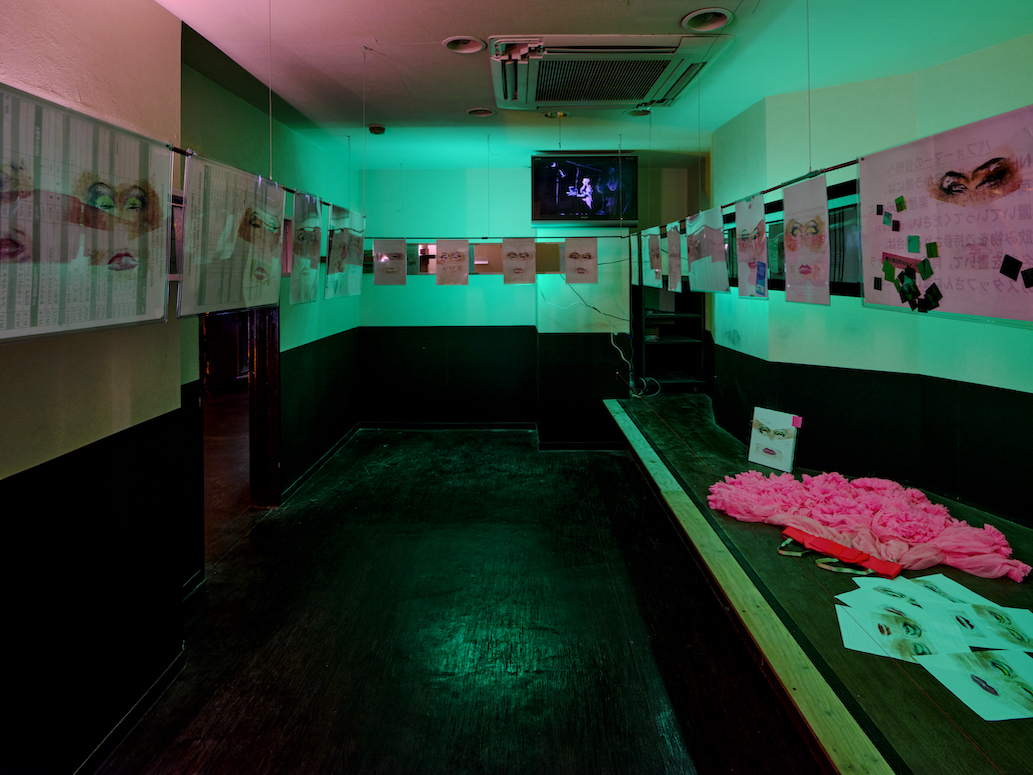
撮影:森田兼次Photo: Kenji Morita
撮影:森田兼次Photo: Kenji Morita
Photo: 夢無子
C. Nude photographs by Aoi Yamada, who is an artist that spans the mainstream, such as the Olympics or movies, and the underground. Yamada interprets the naraku as a hole and sees its femininity and symbol as a uterus, developing nude photoshoots that overlap the body and the naraku as “existences that serve an important role but remain under the surface.”
Photo by Mumuko
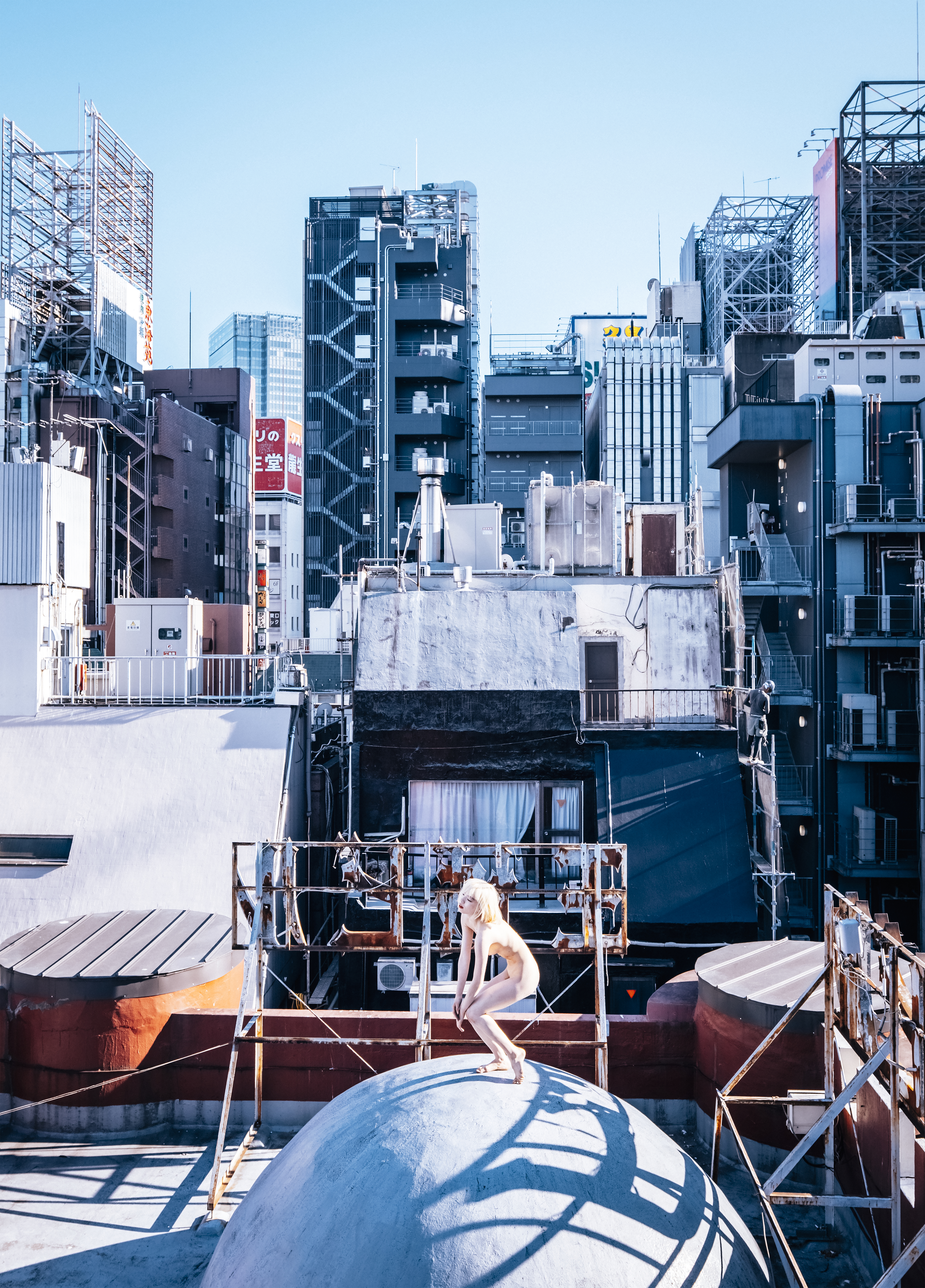
撮影:夢無子Photo: Mumuko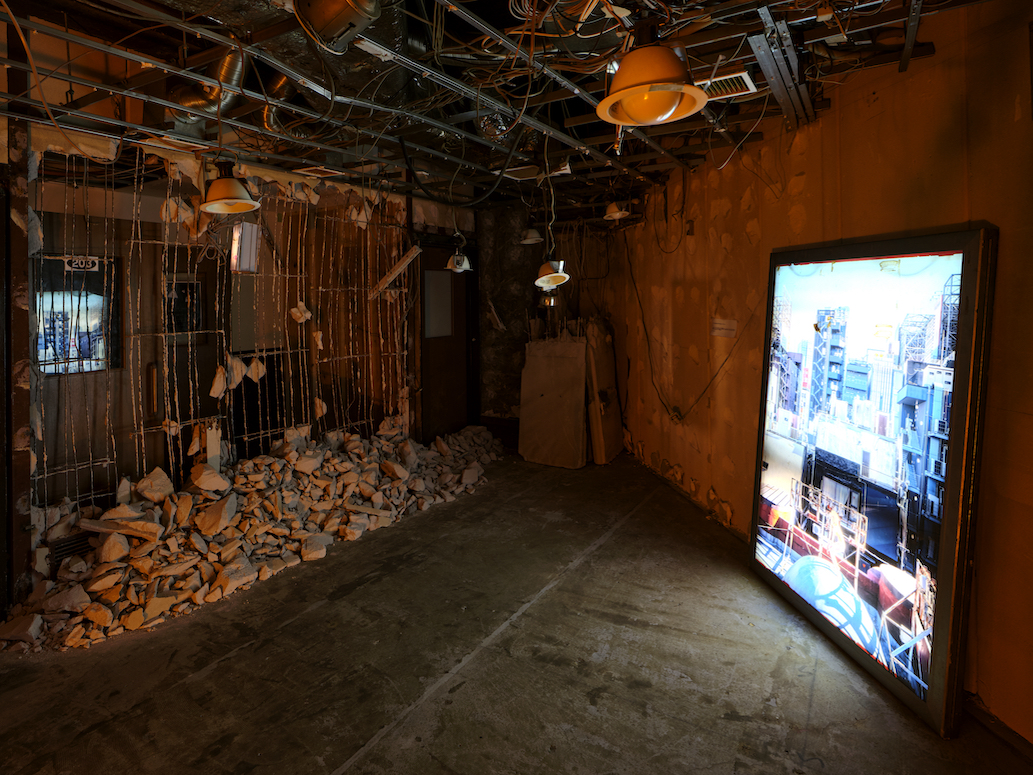
撮影:森田兼次Photo: Kenji Morita
D. Wheelchair dancer Kenta Kambara, who is born with a bifurcated spine, interprets the searchlight as the building’s spine and sees a connection with his own body. He compares the process of cutting a hole in the building and allowing light to extend in a straight line into the sky to the “building’s surgery.” Here, he exhibits his x-ray photograph and a T-shirt he made for himself with the image printed on it.

撮影:森田兼次Photo: Kenji Morita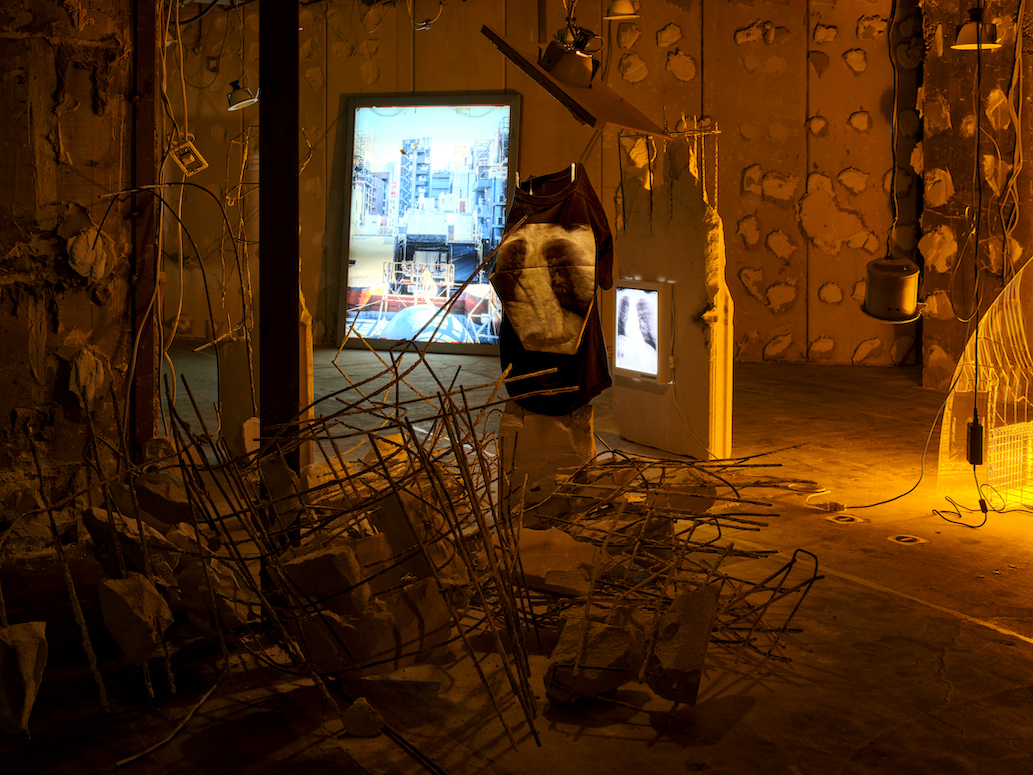
撮影:森田兼次Photo: Kenji Morita
2023
Chim↑Pom from Smappa!Group
マルチチャンネルプロジェクション
パフォーマー全員による「奈落」で行った行為の記録。閉ざされてきた空間でのパフォーマンスと、その空間の開通後に奈落の概念をそれぞれの演者が外へと広げる前後半が交差する。
撮影:
・アオイヤマダ × 夢無子 (photo)
・弁財天KUMI + 高村月 × RYO SATO (photo)
・平位蛙 × Amazing Jiro (特殊メイク) × ANNA FUJIWARA (photo)
・かんばらけんた
・MONDO
・もしもしチューリップ (KUMI、山田ホアニータ、ちびもえこ) × ANNA FUJIWARA (photo)
・キリーシャクレイ × 宮原夢画 (photo)
E. The Making of the Naraku
2023
Chim↑Pom from Smappa!Group
Multi-channel projection
Documentation of an action conducted by all performers at the naraku. The performance in the closed space, and that in the opened up space, where performers expand the notion of the naraku, intersect.
Videography:
- Aoi Yamada x Mumuko (photo)
- Benzaiten KUMI + TukiTakamura x RYO SATO (photo)
- KELO Hirai x Amazing Jiro (special makeup effects) x ANNA FUJIWARA (photo)
- Kenta Kambara
- MONDO
- MoshiMoshi CHULIP (KUMI, Yamada Hoanita, chibiMOEKO) x ANNA FUJIWARA (photo)
- Kily Shakley x Muga Miyahara (photo)
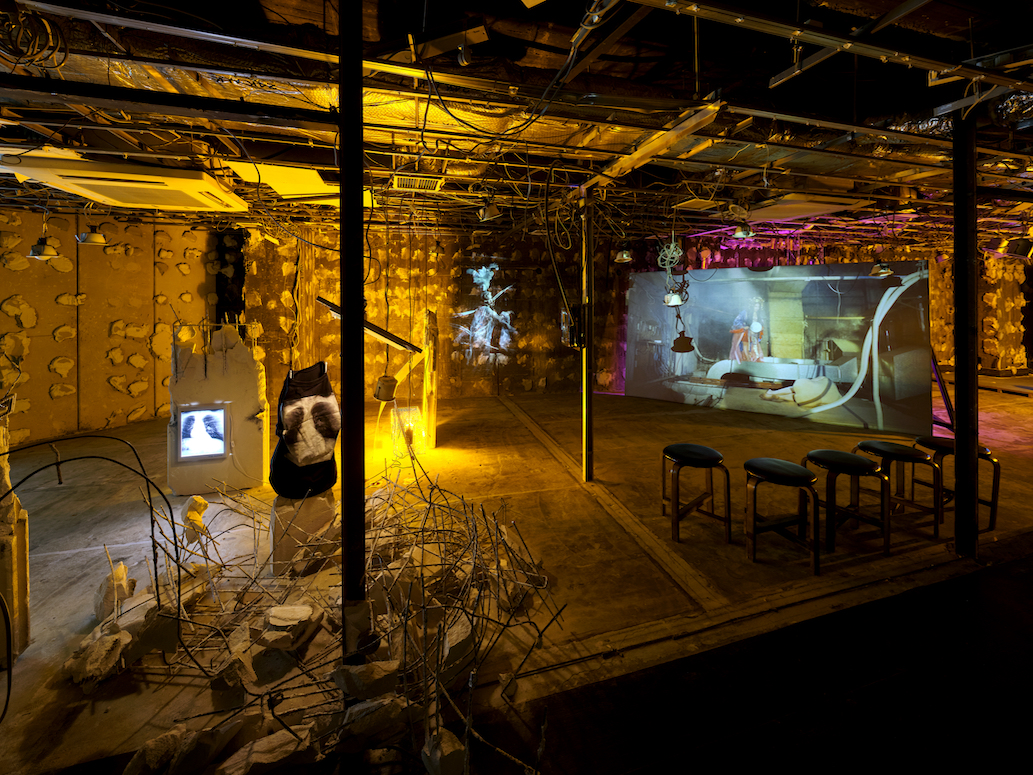
撮影:森田兼次Photo: Kenji Morita
Photo: ANNA FUJIWARA
F. Using the telephone as an icon, MoshiMoshi CHULIP keeps waiting for communication with a fictional being. The photos taken in the first half are used as advertising material that is randomly scattered on the streets in the second half, spreading the telephone number of the Ohjo Building around. This performance even includes the answering machine waiting for calls.
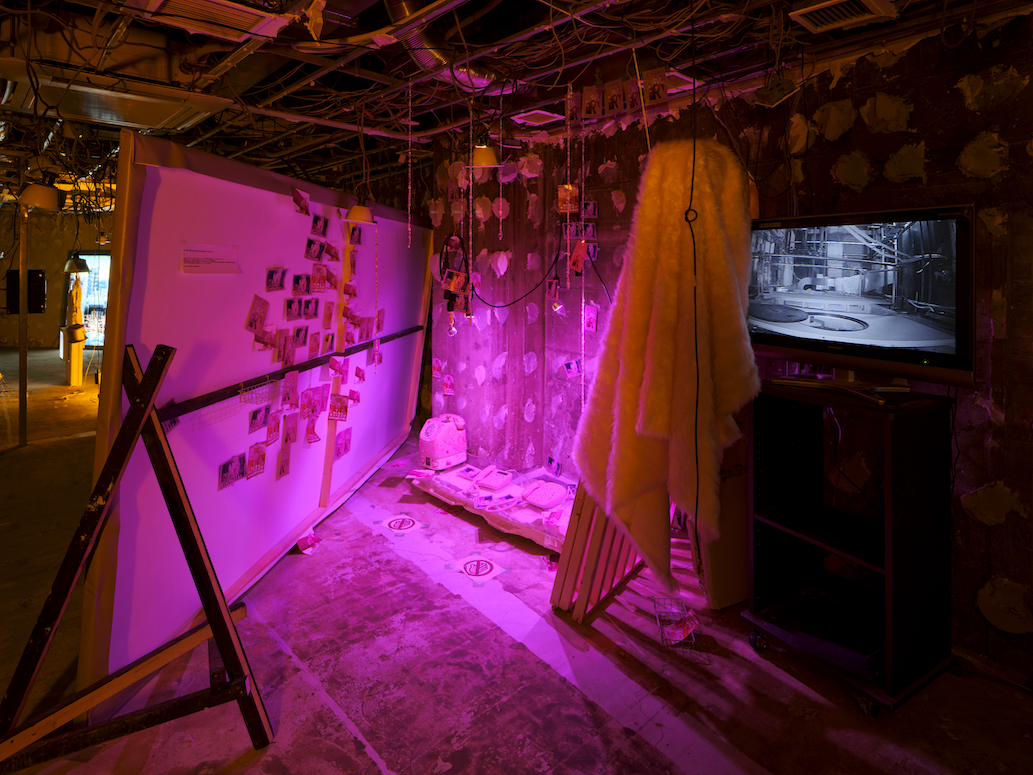
撮影:森田兼次Photo: Kenji Morita
撮影:森田兼次Photo: Kenji Morita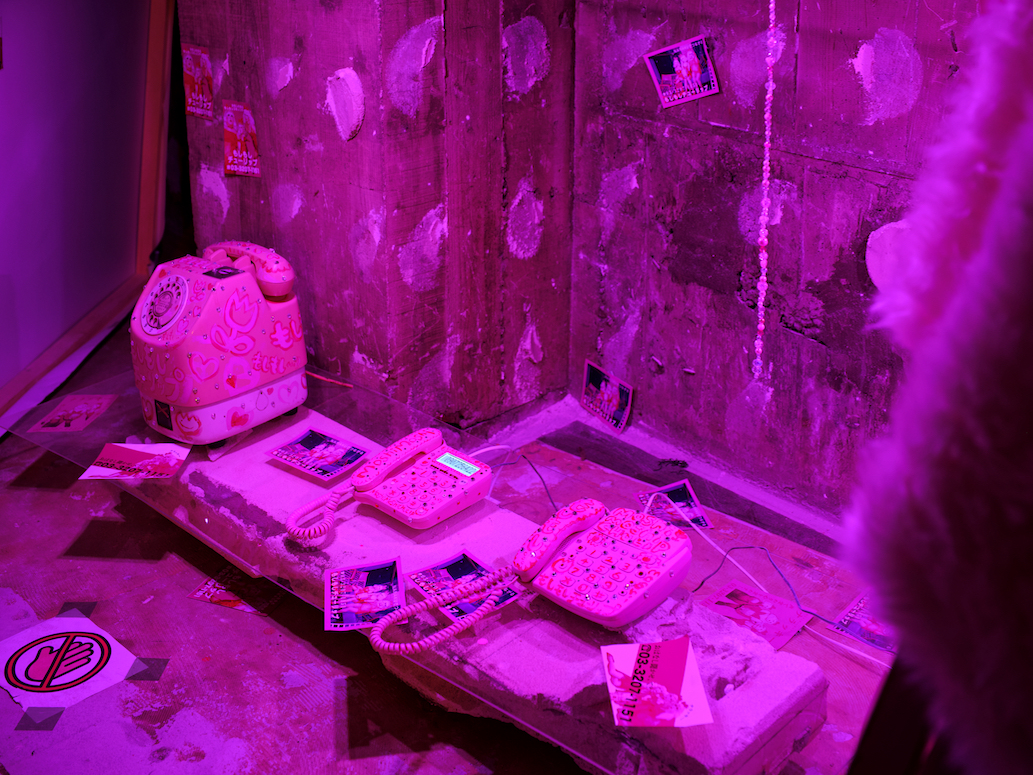
撮影:森田兼次Photo: Kenji Morita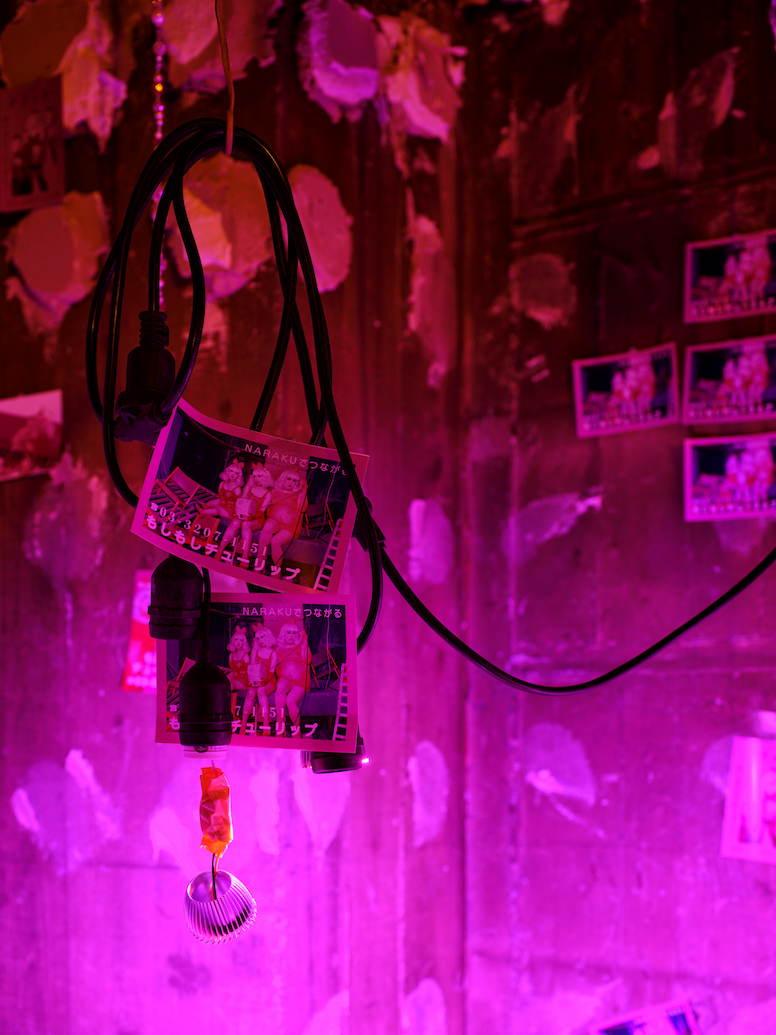
撮影:森田兼次Photo: Kenji Morita
2023
Chim↑Pom from Smappa!Group + KUMI + コンスタン・ヴォアザン
ビデオインスタレーション
本展で弁財天を演じるのは、日本屈指のポールダンサーKUMIである。弁財天として、高村月とともに吉原、歌舞伎町、日本橋でパフォーマンスをしてきたが、その土地土地にも弁天が祀られていたことに縁を感じてきたという。「私」を超越した神を演じるKUMIだが、その根底には在日朝鮮人3世としての「私」への葛藤があった。東京オリンピック2020の前夜祭に出演した際にも、国家事業と自身の立場の関係を問い続けたという。その難しさと最も向き合ったのは、東京ゲゲゲイがDANCE@HEROで優勝した際の作品「世界の果て」のサポートとして、劇中の「君が代」で踊った時だった。主宰のMIKEYとの信頼関係に基づくその行為は後のKUMIに多大な影響を与えたが、今回、再び「君が代」で踊るアイデアが持ち上がったことで葛藤が再来。Chim↑Pomと日本在住のフランス人映像作家コンスタン・ヴォアザンと会議を重ねながら、撮影日前日まで相談を続ける。当日、「奈落」で「君が代」が流れるなか、無人のポールを見つめるKUMIと弁財天KUMI両者の表情が撮影された。
G. I
2023
Chim↑Pom from Smappa!Group + KUMI + Constant Voisin
Video installation
In this exhibition, Benzaiten is played by the pole dancer KUMI. She has performed as Benzaiten together with Tuki Takamura at Yoshiwara, Kabukicho, and Nihonbashi, and says she feels ties with the worship of Benten at each of these places. KIMI plays the role of a divinity transcending “I,” but underlying this performance was a struggle with “I” as a third-generation Korean residing in Japan. She confessed that, when she performed at a festival on the eve of the opening of the Tokyo 2020 Summer Olympics, she continued to question the relationship between what was a national project and her own status. The most direct confrontation with this thorny issue came when she danced to “Kimigayo,” the Japanese national anthem, in a supporting role in Sekai no Hate (which translates “the end of the world”), a work for which Tokyo Gegegay won first prize in the DANCE@HERO competition. This act was grounded in the bonds of trust with MIKEY, the troupe’s leader, and exerted an immense impact on KUMI from then on. However, the mental tussle resurfaced when the idea of dancing “Kimigayo” was raised again. The issue was the subject of repeated discussion with Chim↑Pom and Constant Voisin, a French video artist residing in Japan, and the consultation continued right up to the day before the scheduled shooting. On that day, “Kimigayo” played in the naraku, and the camera recorded the expressions of both the KUMI staring at the performerless pole and the KUMI playing Benzaiten.
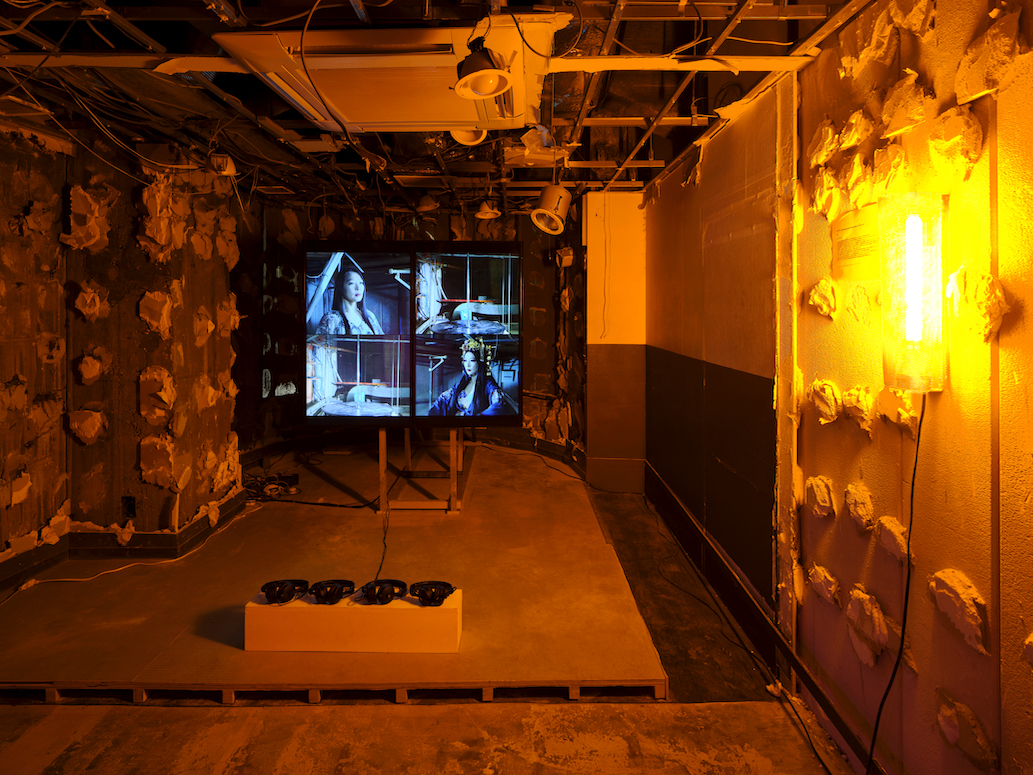
撮影:森田兼次Photo: Kenji Morita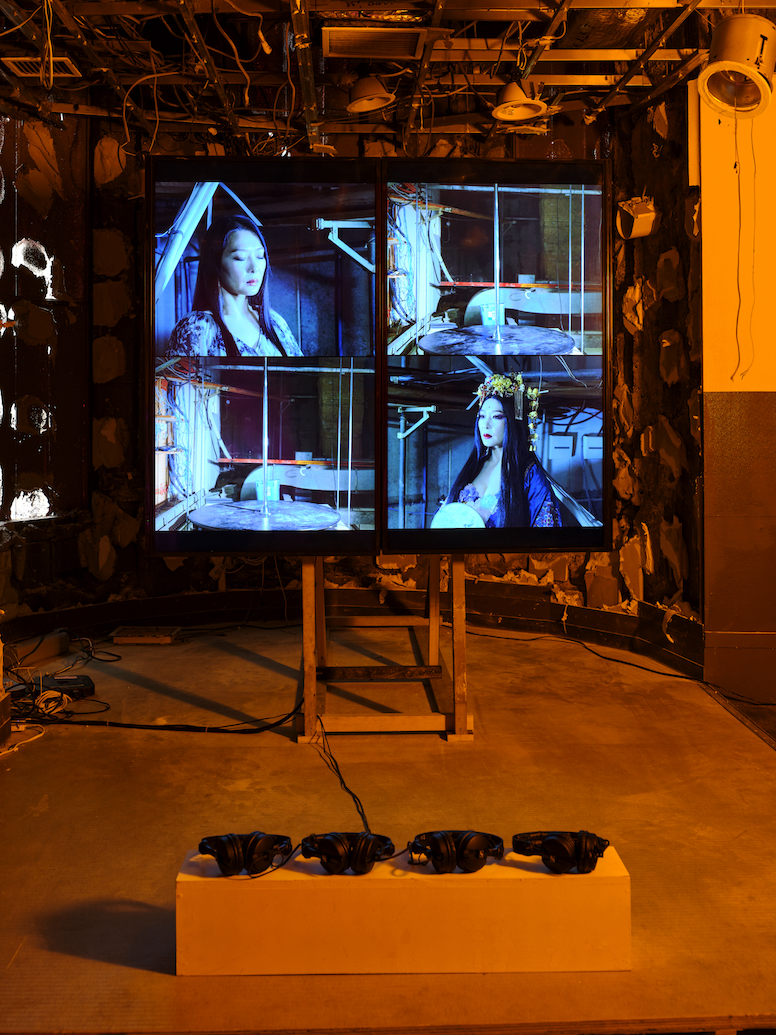
撮影:森田兼次Photo: Kenji Morita
Photo: 宮原夢画
H. A video featuring the burlesque dancer Kily Shakley, based on the accidental death of a performer with the Takarazuka company after a fall into the naraku (theater basement). Although the naraku is a safe zone for performers because, unlike on the stage, they cannot be seen by the audience there, it is also a dangerous one holding the risk of a fall. As a showgirl, Shakley talks about how, by getting on stage, performers are indeed risking their lives not only mentally but also physically.
Photo by Muga Miyahara
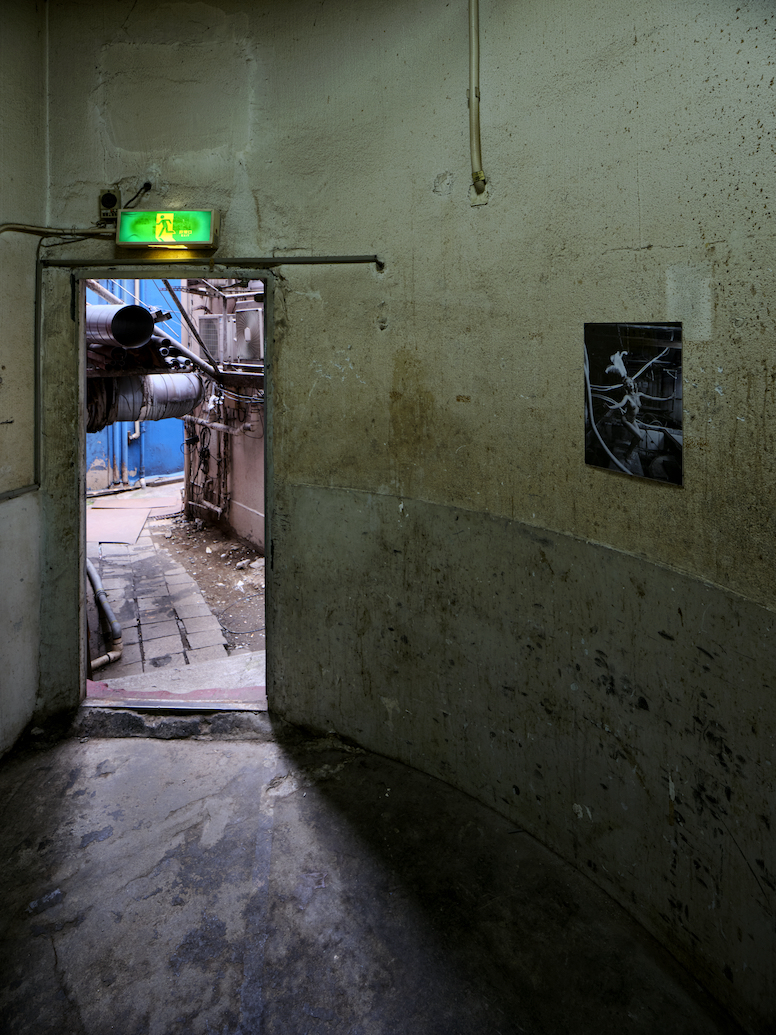
撮影:森田兼次Photo: Kenji Morita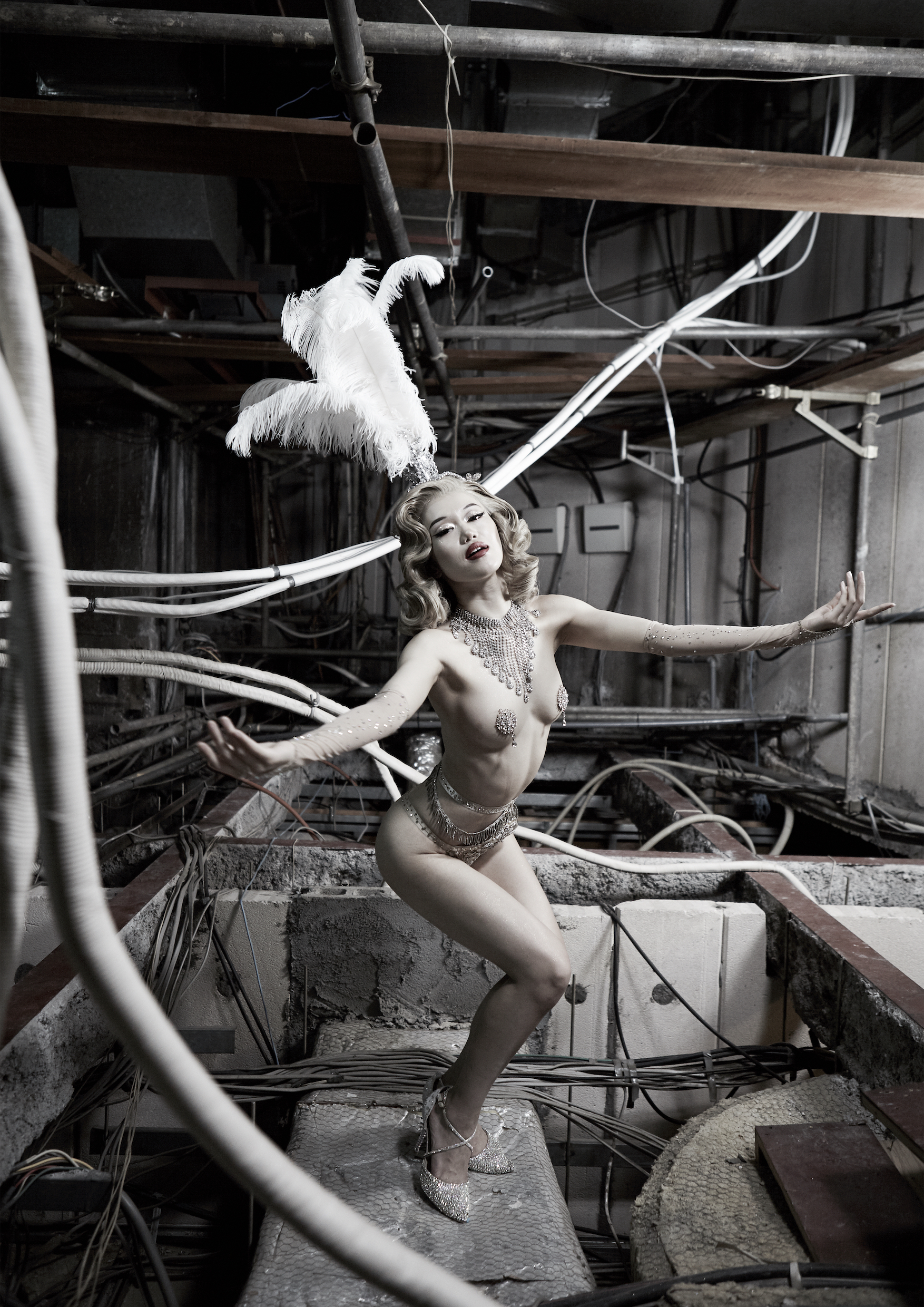
撮影:宮原夢画Photo: Muga Miyahara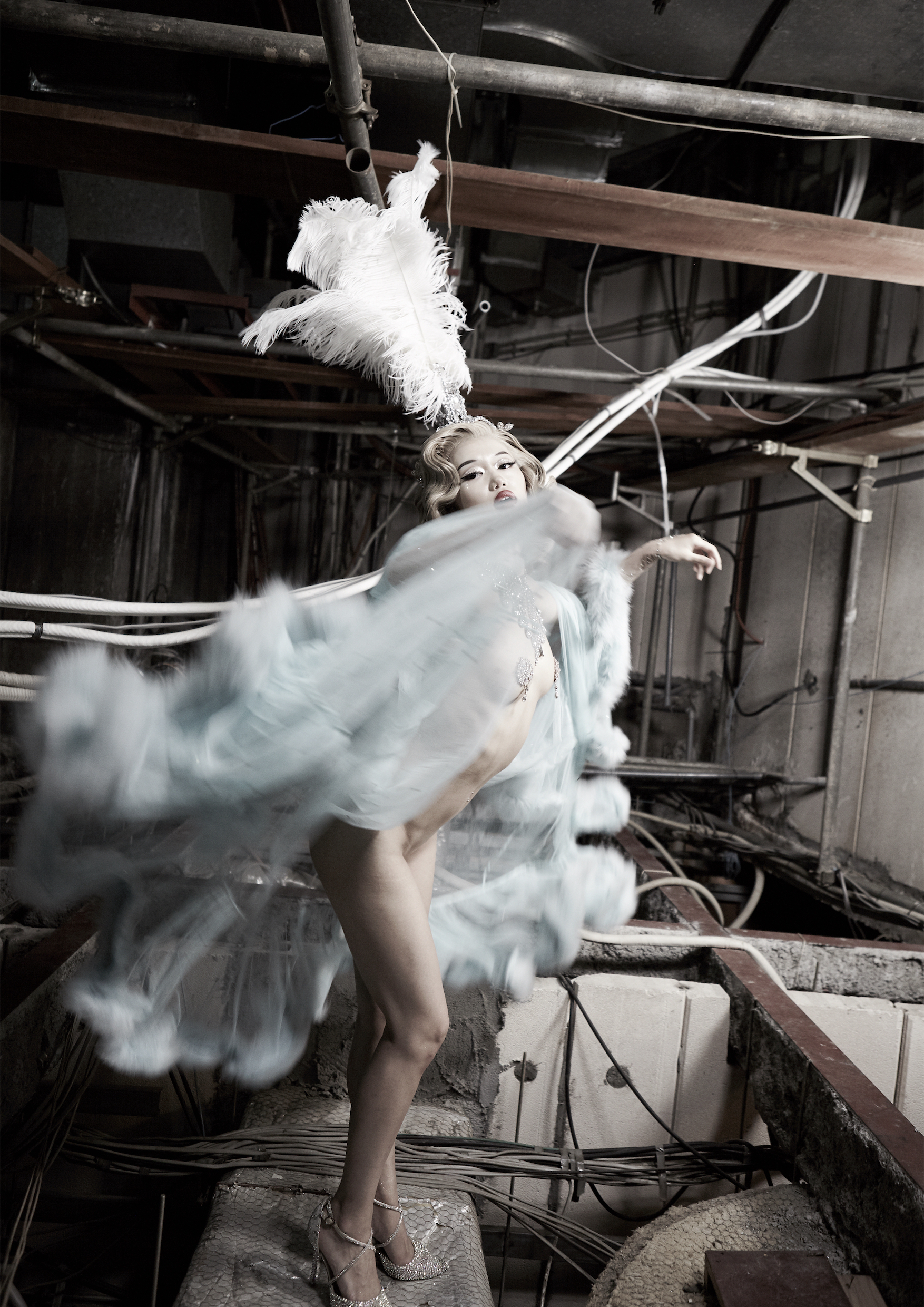
撮影:宮原夢画Photo: Muga Miyahara
360度カメラによる自撮り映像は、常にネズミを中心に捉え編集。
そのため周辺 (歌舞伎町の雑沓) は常に歪んでいる。
E.には「奈落」での映像を収録。また、隙間を縫うよう館内に分散展示。
特殊メイク: Amazing Jiro
I. Using special makeup to look like a crow or rat, KELO Hirai wanders the streets as a rat and gets into the naraku through cracks in building walls and manholes. Footage of him slipping through openings is displayed here and there in the venue.
Special makeup: Amazing Jiro
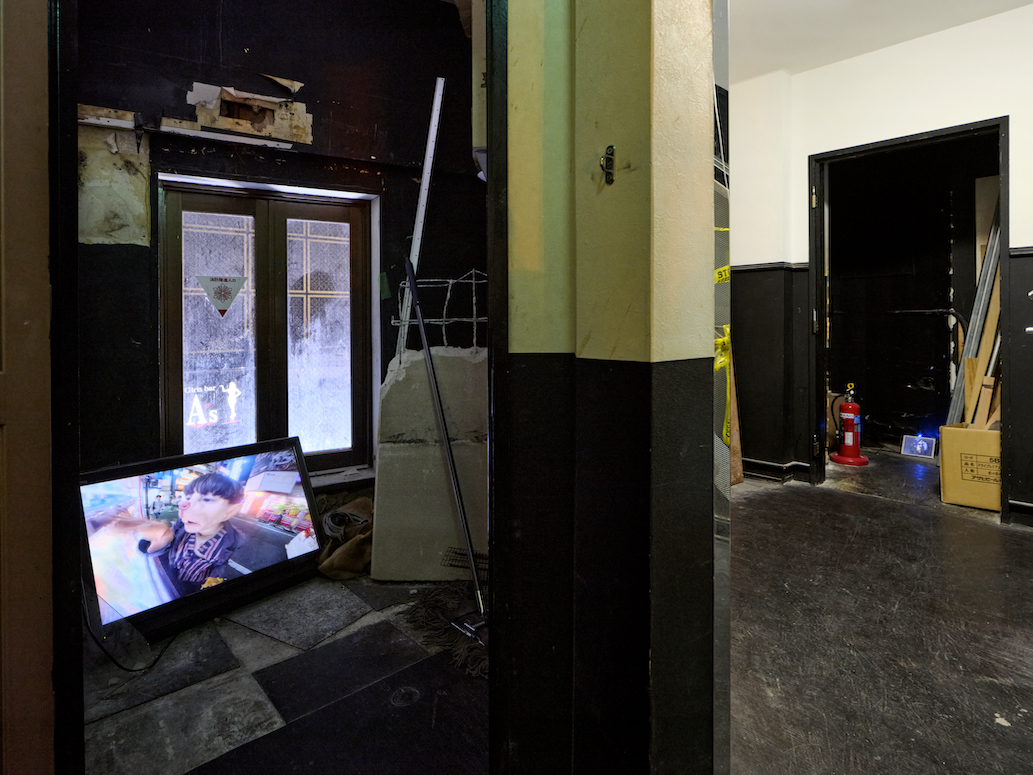
撮影:森田兼次Photo: Kenji Morita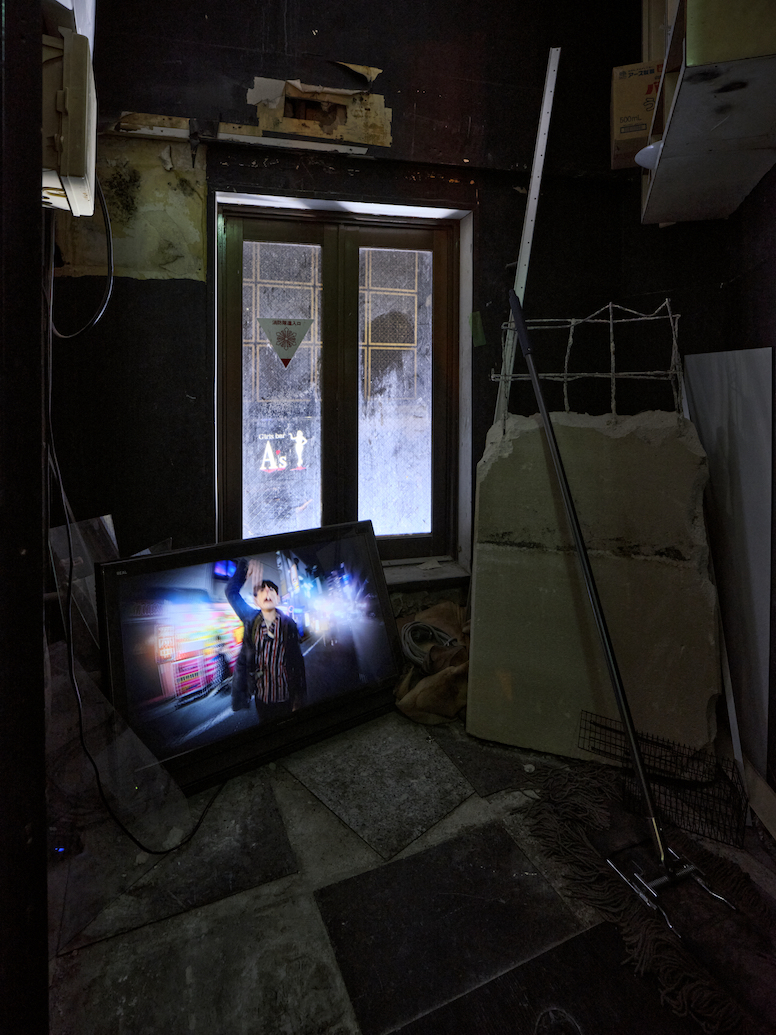
撮影:森田兼次Photo: Kenji Morita
- ---
4階4th Floor open/close -
5. 神曲 ― La Divina Commedia
2023
Chim↑Pom from Smappa!Group
カラオケのパーティールーム、マルチメディア
制作・デザイン: 西村健太、稲永英俊
かつてカラオケ居酒屋として一世を風靡した王城。「402号室」をカラオケのパーティールームとしてリノベーション。
正面玄関受付でルームナンバーが明記されたバインダーを受け取った観客は、全員カラオケ歌い放題。
5. La Divina Commedia
2023
Chim↑Pom from Smappa!Group
Karaoke party room, multimedia
Design and Production: Kenta Nishimura, Hidetoshi Inanaga
Ohjo once commanded immense popularity for its karaoke izakaya tavern. Room 402 was remodeled into a karaoke party room. Visitors who receive a binder on which the room number is written at the front entranceare entitled to sing as much as they want in this room.
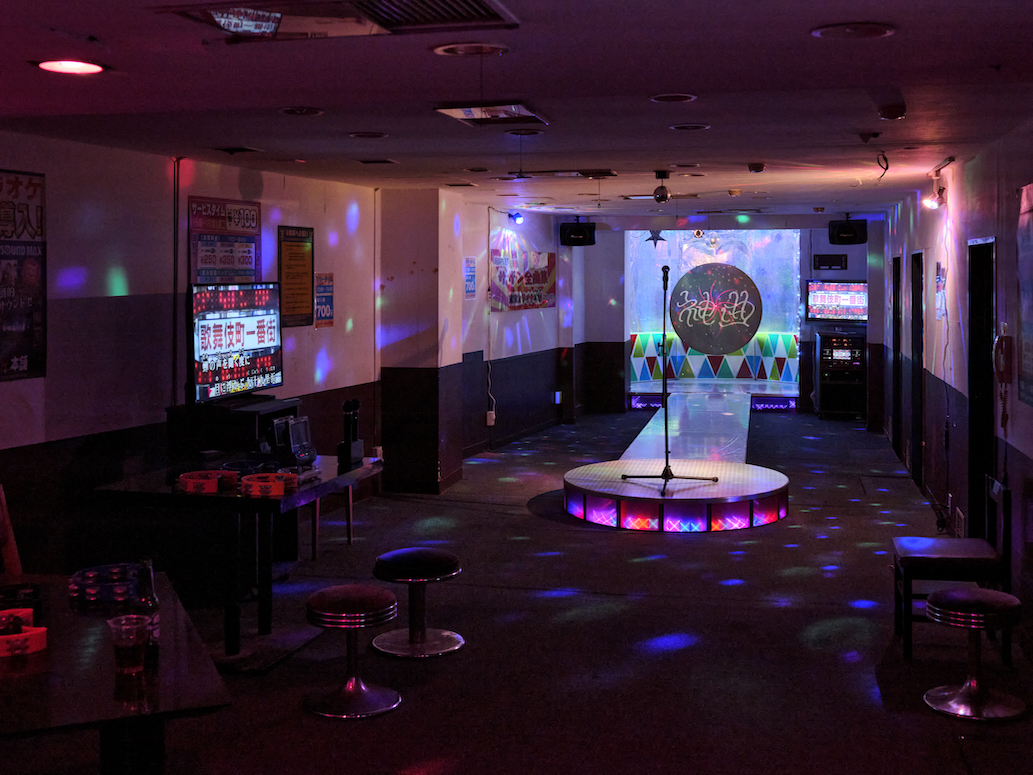
神曲 ― LaDivinaCommediaLa Divina Commedia
撮影:森田兼次Photo: Kenji Morita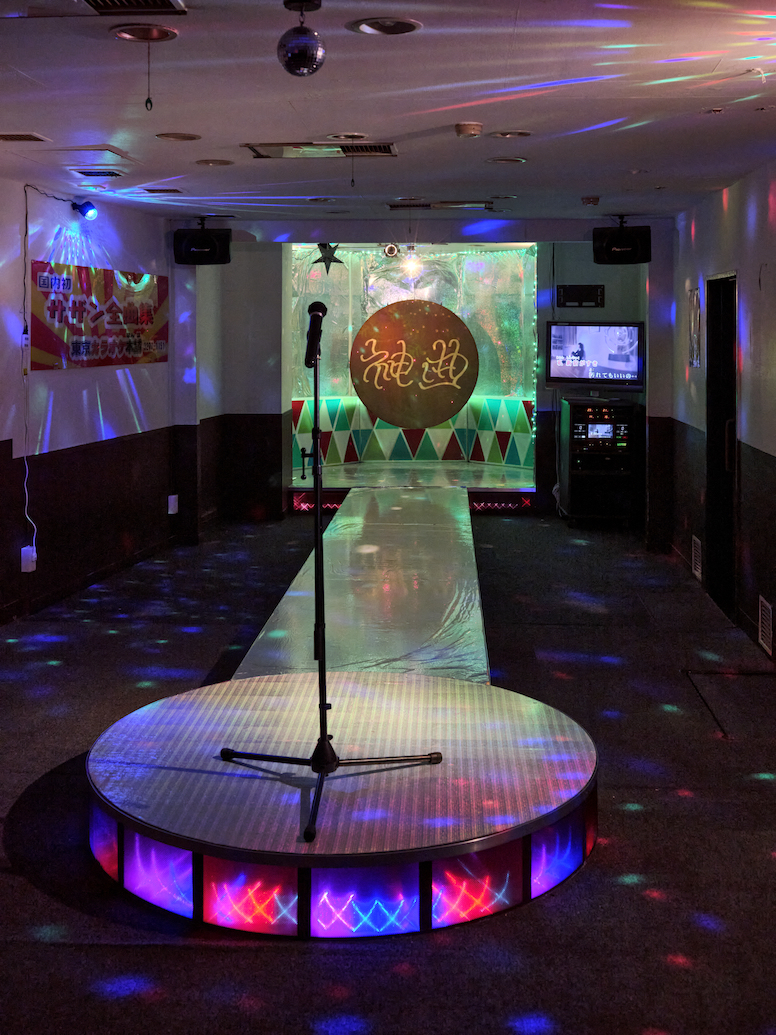
神曲 ― LaDivinaCommediaLa Divina Commedia
撮影:森田兼次Photo: Kenji Morita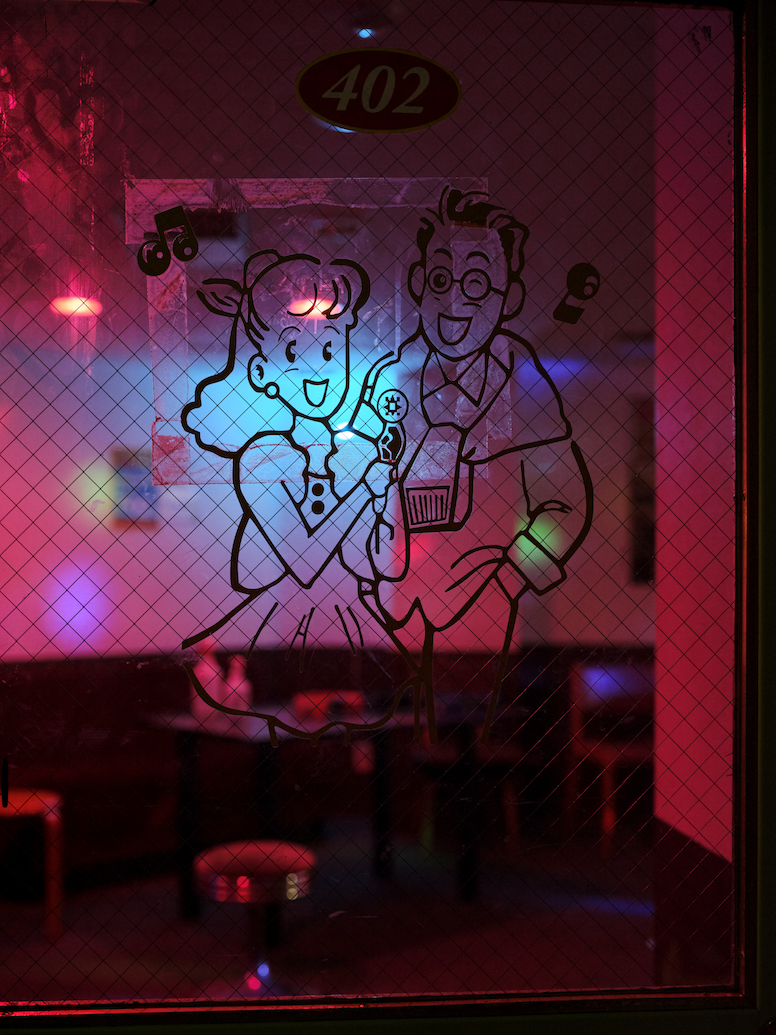
神曲 ― LaDivinaCommediaLa Divina Commedia
撮影:森田兼次Photo: Kenji Morita
- ---
5階以上5th Floor Rooftop open/close -
6. 光は新宿より
2023
Chim↑Pom from Smappa!Group
サイアノタイプ、看板
パネル制作: 山村一輝
夜の時間に視認できる、「奈落」の中から天空に伸びるサーチライトの光。向かって右手には、サイアノタイプ (青写真) 製の看板「光は新宿より」。終戦直後、焼け野原と化した新宿を地ならしし、電柱を建て、戦後初の闇市「新宿マーケット」を立ち上げた関東尾津組による、物資買取のための新聞広告と市場に掲出されたスローガンである。
6. Hikari wa Shinjuku yori
2023
Chim↑Pom from Smappa!Group
Cyanotype, billboard
Panel production: Kazuki Yamamura
The beam of a searchlight visible at night, shooting up to the sky from the naraku. On the right is a billboard made with cyanotype, emblazoned with the words hikari wa Shinjuku yori (the light starts from Shinjuku). Wartime air raids transformed the whole Shinjuku district into a field of burnt-out ruins. Right after the war, the Kanto Ozu gang prepared the land, put up telephone poles, and set up the Shinjuku Market, the first black market in postwar Tokyo. The aforementioned words were the slogan that the gang put in newspaper ads and in markets in order to promote their purchase of materials.
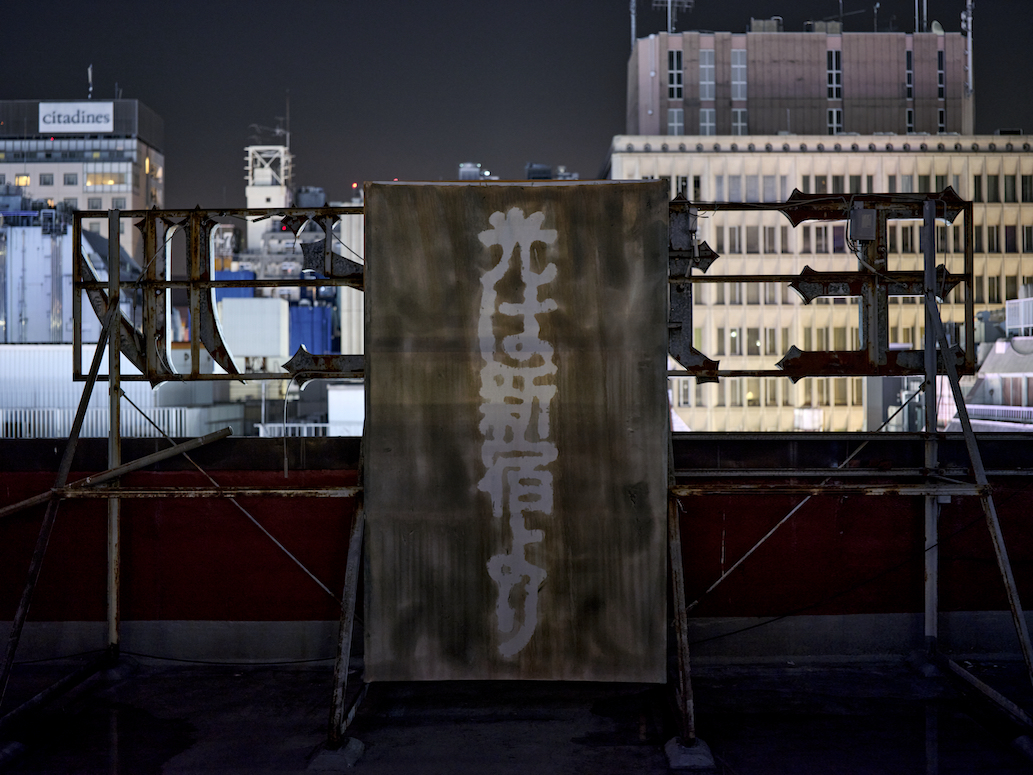
光は新宿よりHikari wa Shinjuku yori
撮影:森田兼次Photo: Kenji Morita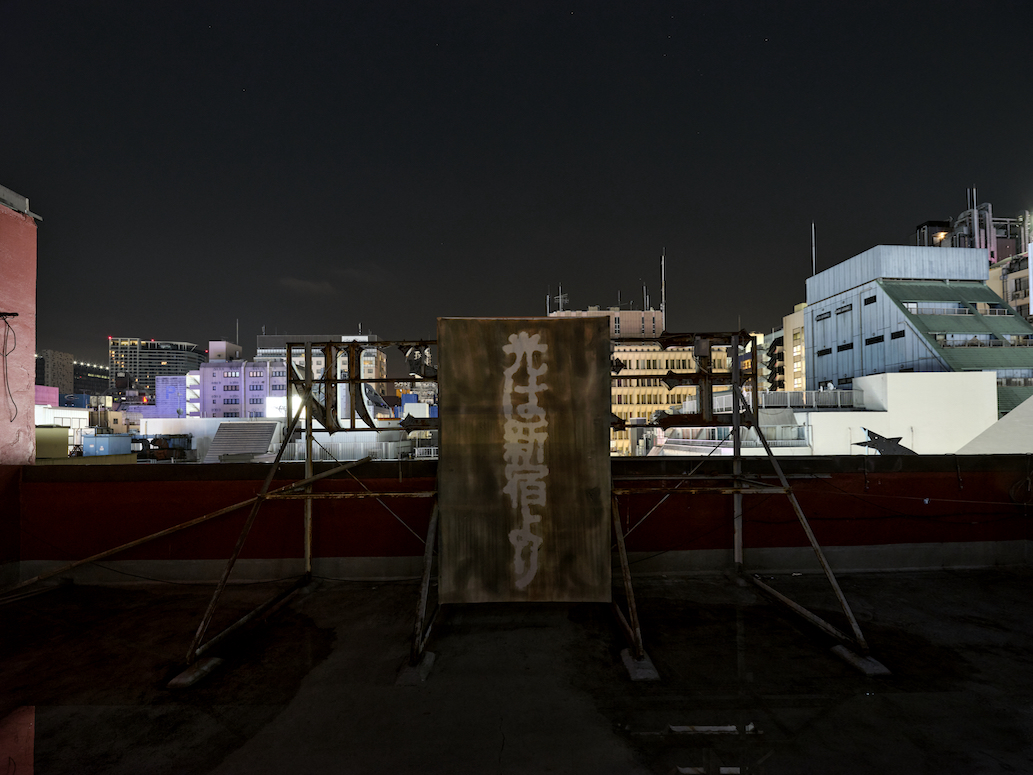
光は新宿よりHikari wa Shinjuku yori
撮影:森田兼次Photo: Kenji Morita
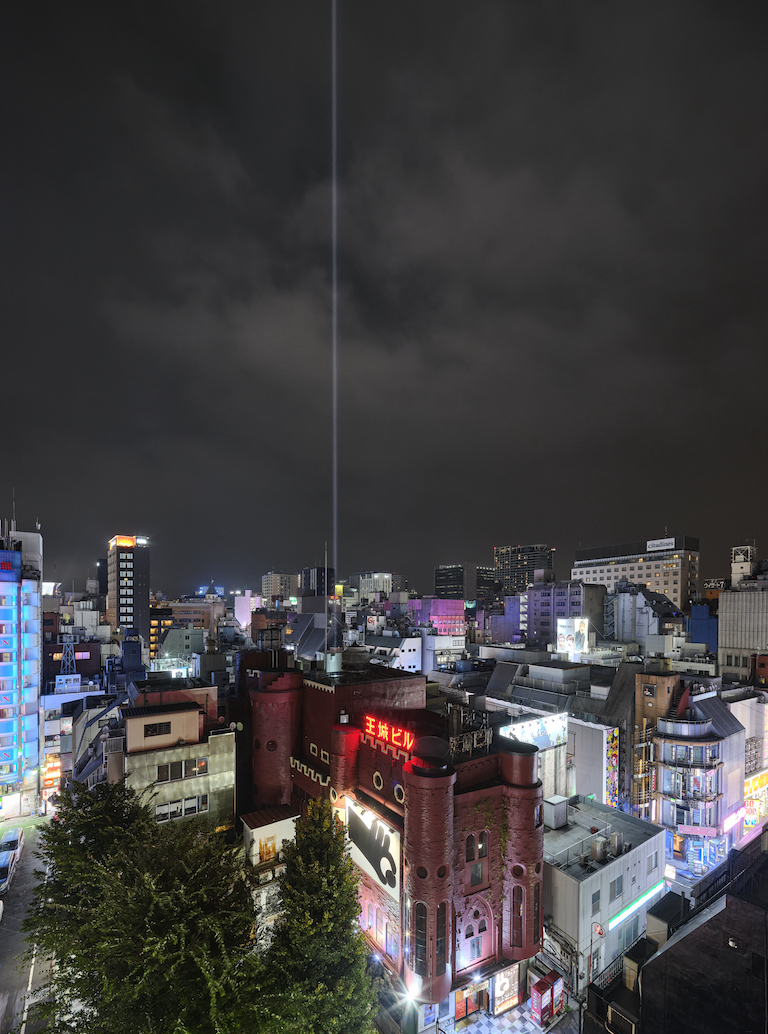
撮影:森田兼次Photo: Kenji Morita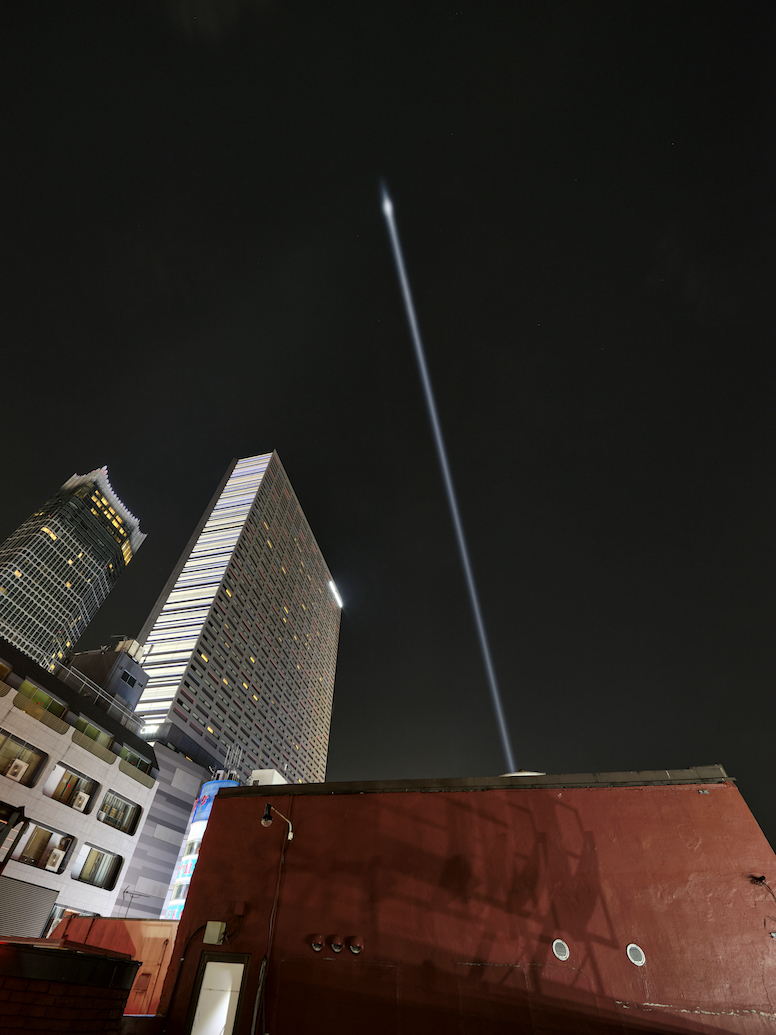
撮影:森田兼次Photo: Kenji Morita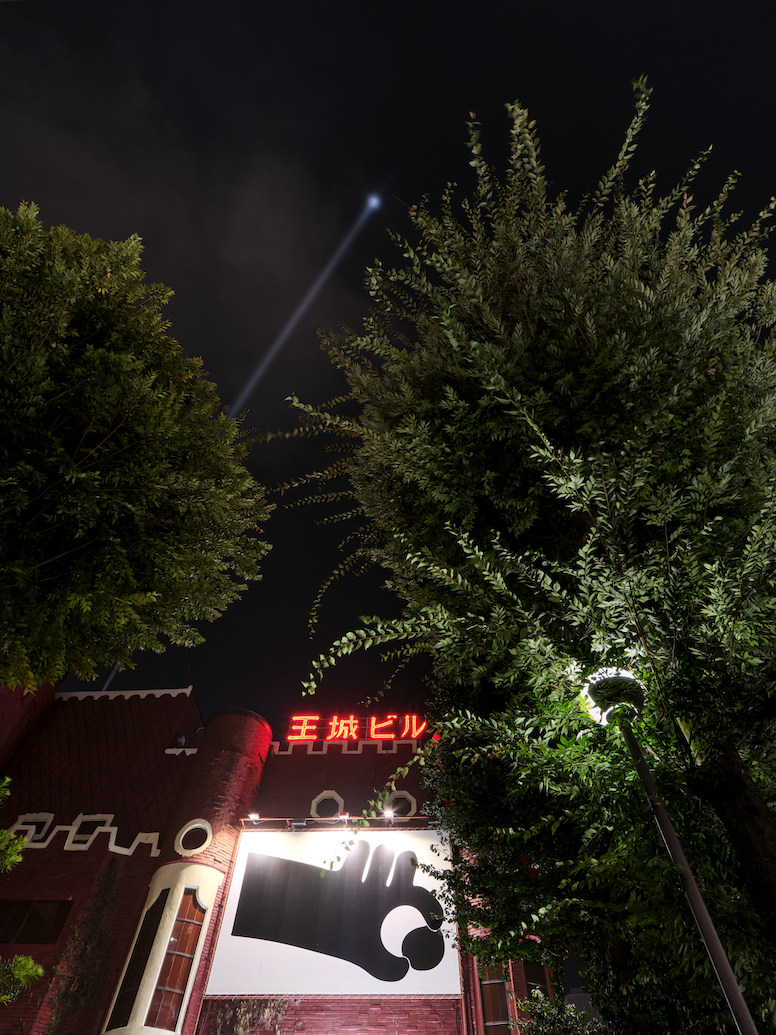
撮影:森田兼次Photo: Kenji Morita
- ---
地下1階First lower level open/close -
7. Asshole of Tokyo
2019
Chim↑Pom from Smappa!Group
映像、音イべントフロア。地下に流れる水をテーマとし、東京のマンホールの下の下水道を撮影したChim↑Pomの映像作品のタイトルをクラブ名に引用。「都市の排泄の穴」に「東京のクソ野郎」としてのChim↑Pom from Smappa!Group自らを重ねあわせ、会期中Smappa!Groupプレゼンツによる音楽やファッションのイベントを複数回開催。
● イベント情報は随時こちらに更新。
7. Asshole of Tokyo
2019
Chim↑Pom from Smappa!Group
Video, sound
The event floor. Taking water flowing underground as its theme, this is a video work that Chim↑Pom made by shooting sewerage under manholes in Tokyo. Its title was used for the name of a club. It has the double entendre of “anus for evacuation of metropolitan bowels” and characterization of Chim↑Pom from Smappa!Group as “Tokyo jerks.” During the run of the show, Smappa!Group is going to hold a number of musical and fashion events.
● Click this link for updated information on the events.

Asshole of TokyoAsshole of Tokyo
撮影:森田兼次Photo: Kenji MoritaAsshole of TokyoAsshole of Tokyo
撮影:森田兼次Photo: Kenji Morita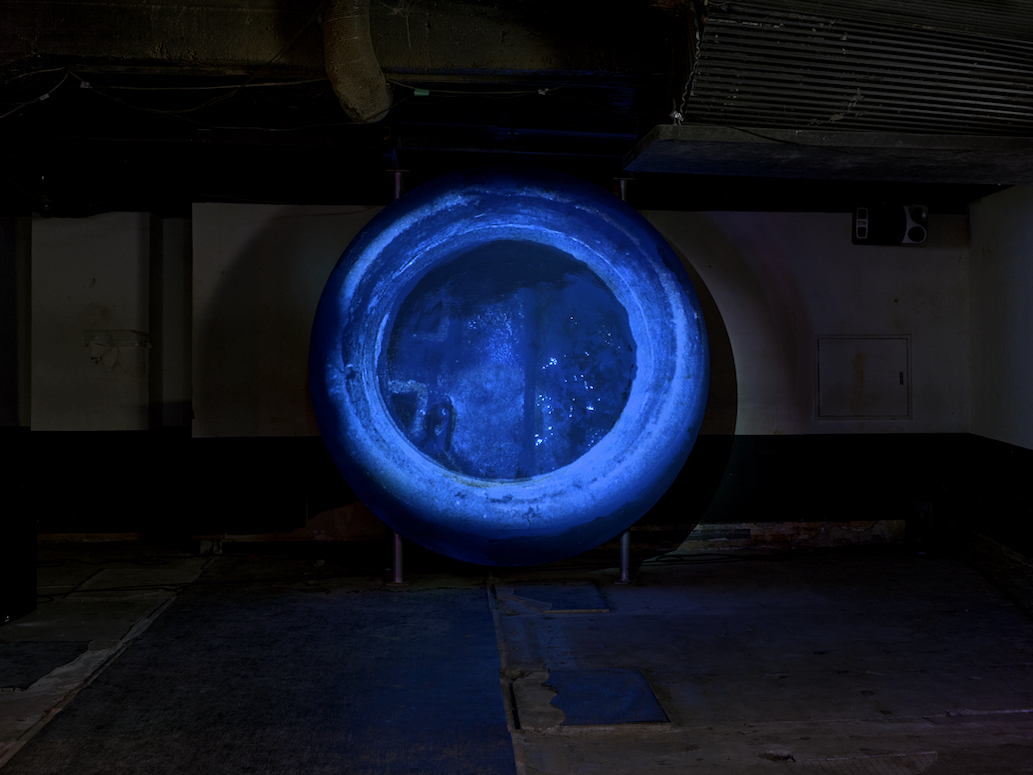
Asshole of TokyoAsshole of Tokyo
撮影:森田兼次Photo: Kenji Morita
8. 餌
2023
Chim↑Pom from Smappa!Group
養殖場、映像、レストラン
養殖場制作: 渡辺志桜里
映像制作: 福田亮
「地獄」を意味する「奈落」。喰う喰われるの関係からヒトの角質を食すドクターフィッシュを養殖し、1階の「にんげんレストラン」の食材とする。展覧会の観客とイベントの参加者は全員角質取り放題。
8. Feed
2023
Chim↑Pom from Smappa!Group
Culture pond, video, restaurant
Culture pond production: Shiori Watanabe
Video production: Ryo Fukuda
Naraku also means “hell.” Inspired by the idea of “eat and be eaten,” this project consists of the culturing of doctor fish, which are fed on human corneous tissue, and their preparation as food served at Ningen Restaurant on the first floor. The show visitors and event participants can have the fish remove corneous tissue as long as they want.
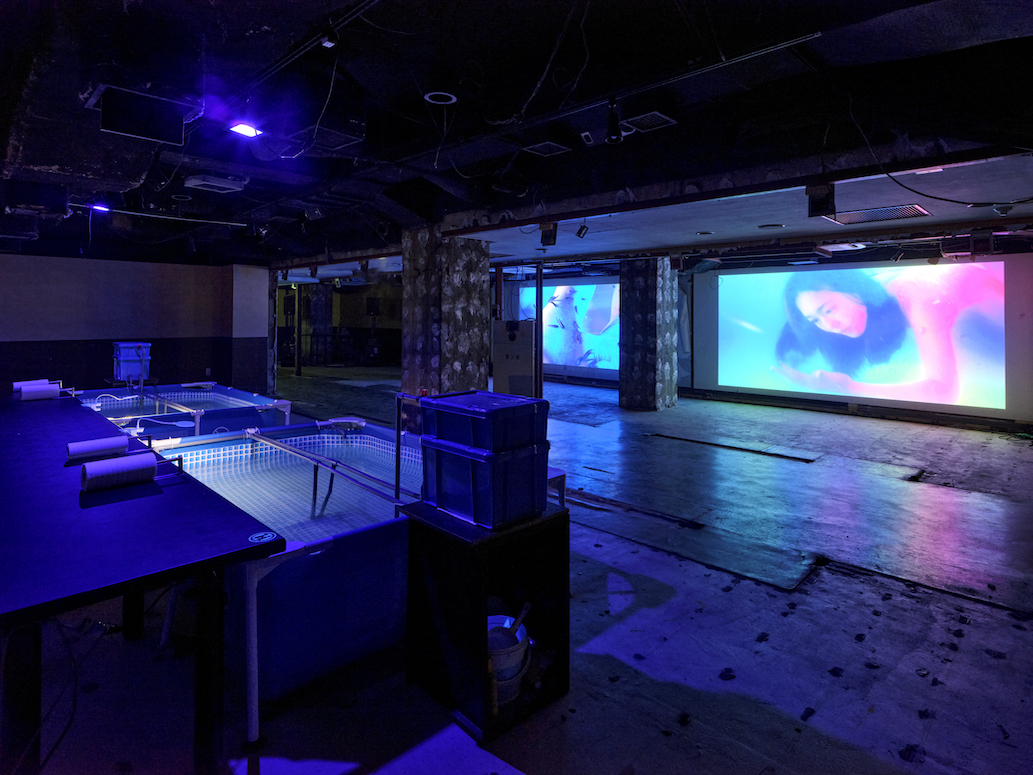
餌Feed
撮影:森田兼次Photo: Kenji Morita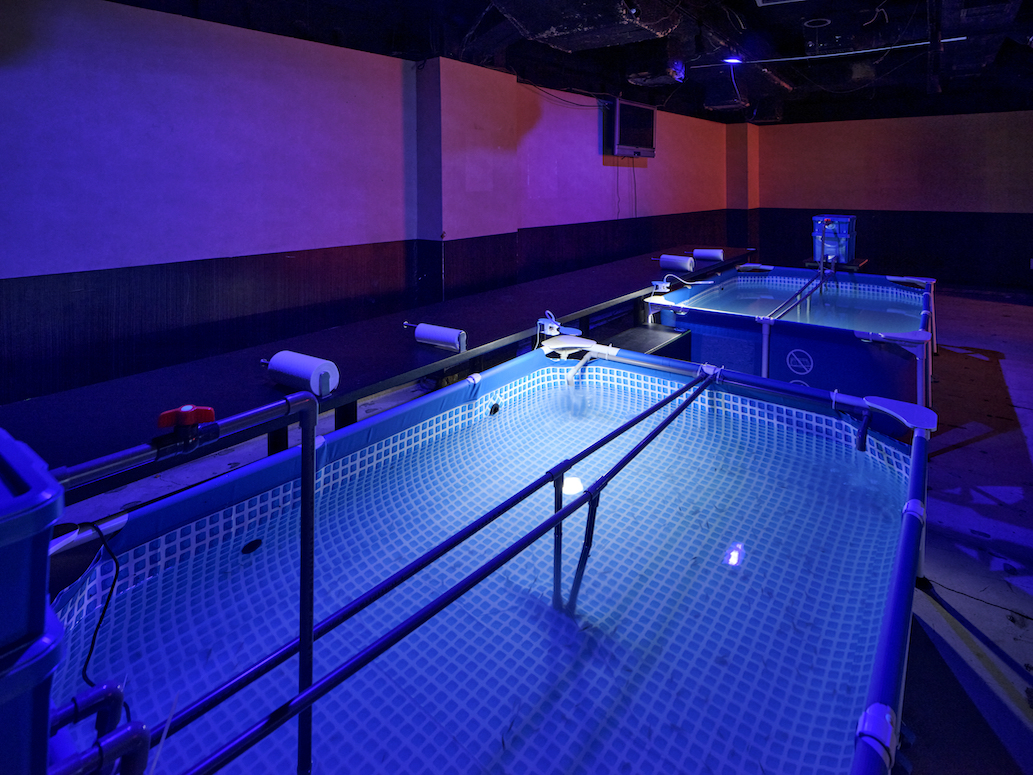
餌Feed
撮影:森田兼次Photo: Kenji Morita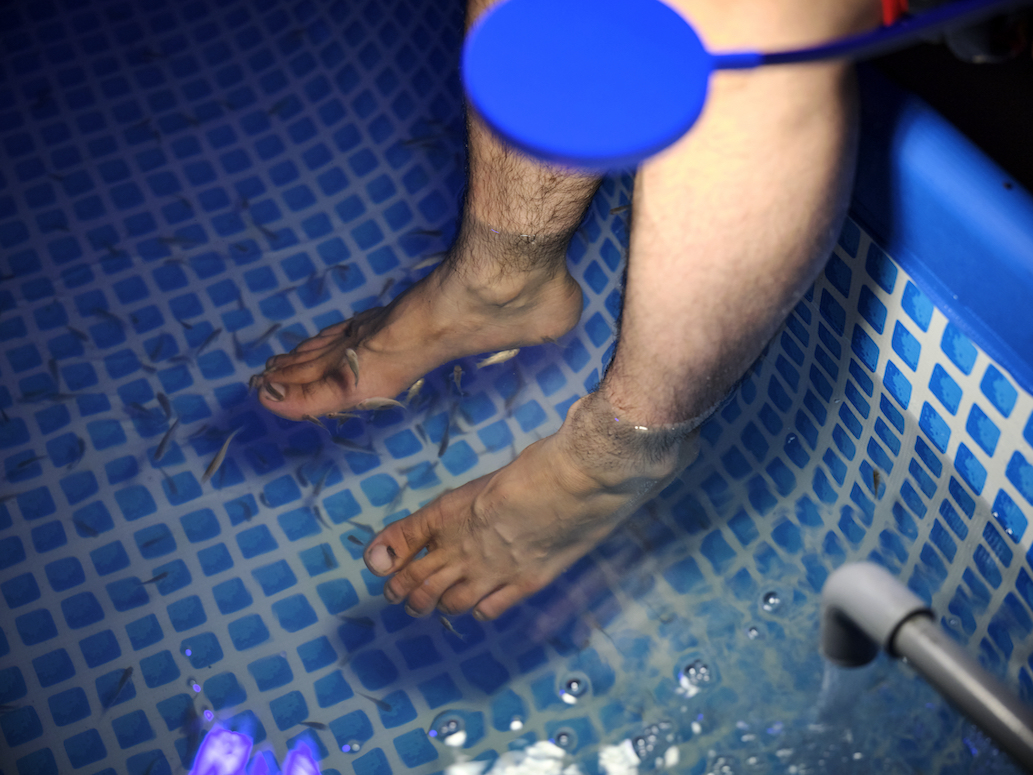
餌Feed
撮影:森田兼次Photo: Kenji Morita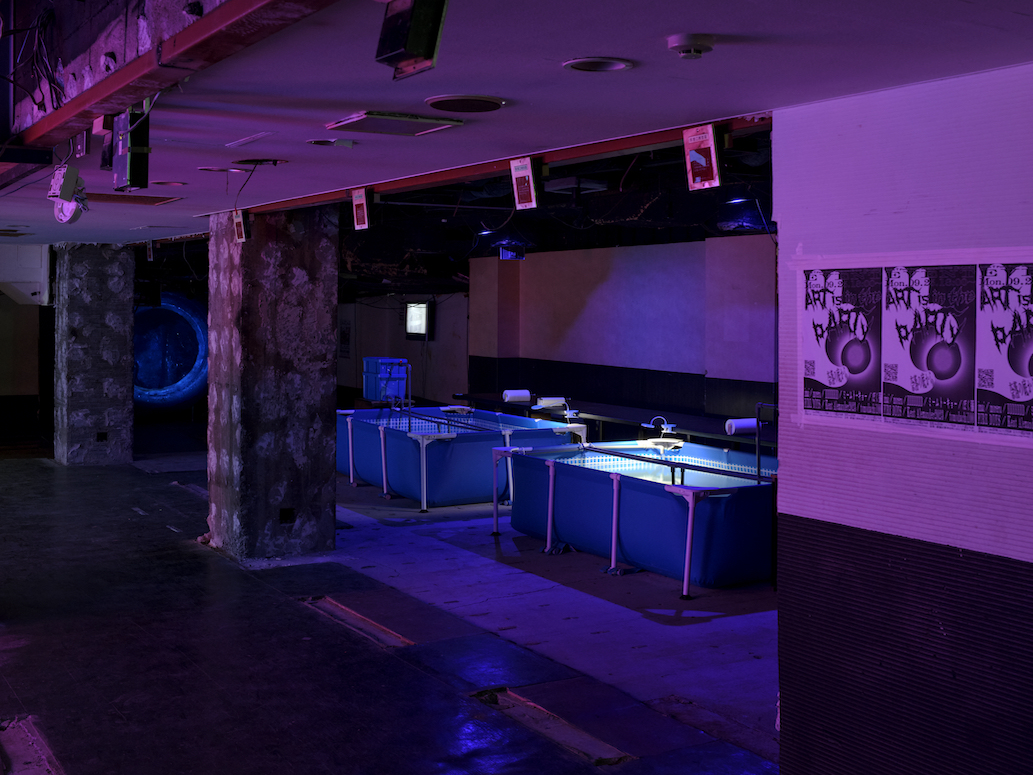
餌Feed
撮影:森田兼次Photo: Kenji Morita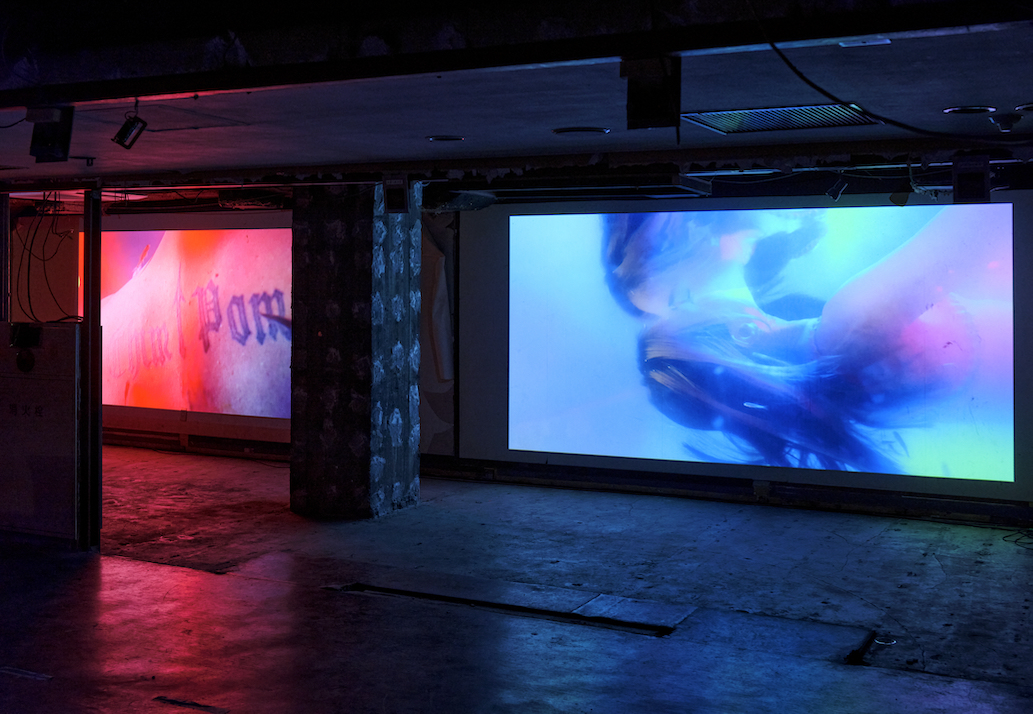
餌Feed
撮影:森田兼次Photo: Kenji Morita
- ---
1階First floor open/close -
9. 穴
2023
Chim↑Pom from Smappa!Group
サイトスペシフィックインスタレーション
ハシゴ、マンホール、王城ビル
梯子制作: 笹原花音
2階の吹き抜け空間のフロアを解体し、1階とシームレスにすることで街と奈落を接続する。
9. Hole
2023
Chim↑Pom from Smappa!Group
Site-specific installation, ladder, manhole, Ohjo Building
Ladder production: Kanon Sasahara
Chim↑Pom tore out the floor in the atrium space on the second floor, for a seamless connection with the first floor and linkage between the street and the naraku.
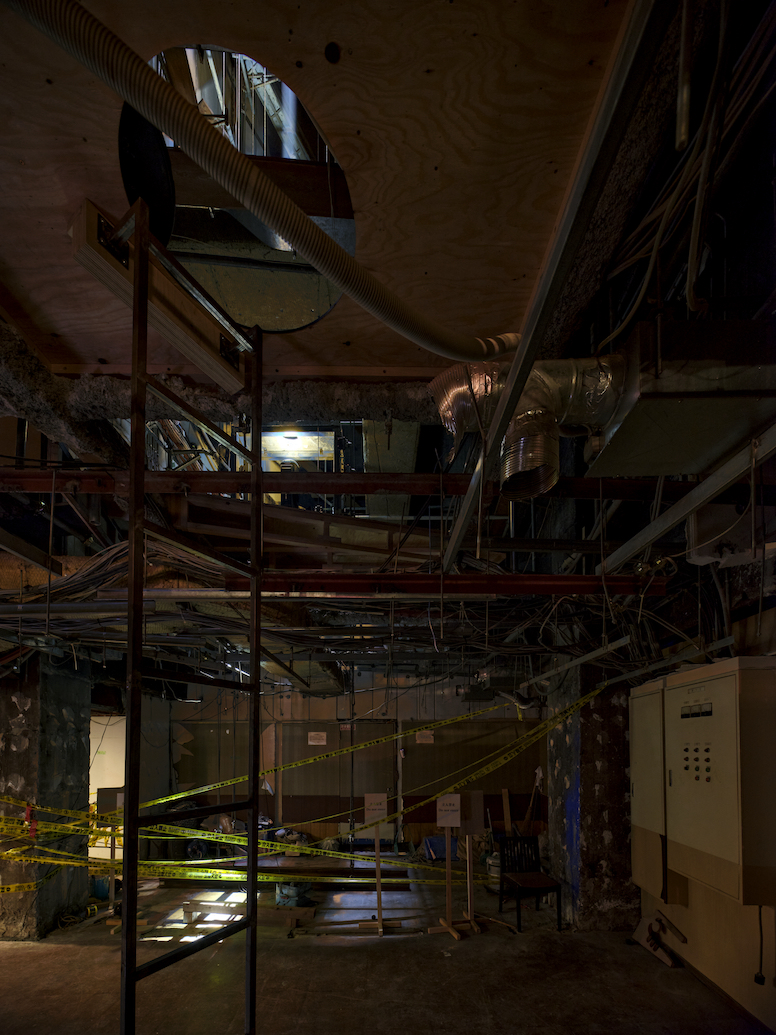
穴Hole
撮影:森田兼次Photo: Kenji Morita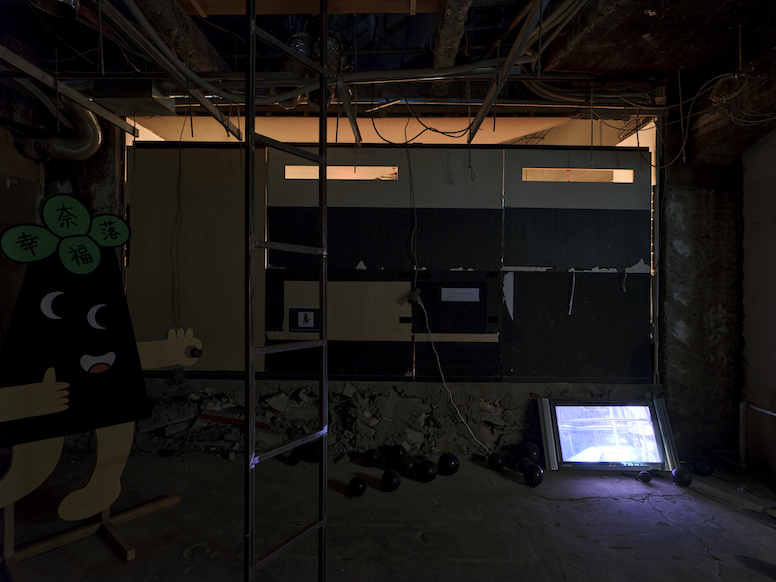
穴Hole
撮影:森田兼次Photo: Kenji Morita
穴Hole
撮影:森田兼次Photo: Kenji Morita
穴Hole
撮影:森田兼次Photo: Kenji Morita
10. にんげんレストラン
2019、2023
インスタレーション
空間デザイン: 西村健太、Chim↑Pom from Smappa!Group
映像制作: 石谷岳寛
2018年にChim↑Pomが歌舞伎町ブックセンター跡の廃墟に開店したパフォーマンスベースのレストランプロジェクト「にんげんレストラン」のポップアップ。本家は旧ロボットレストラン前にSmappa!Groupが構える「人間レストラン」。今回はミュージアムカフェ的なポジションとして食に特化し、アメリカの死刑囚が最期にオーダーしたラストミールをはじめ、奈落弁当、地下で養殖されているドクターフィッシュなどのメニューを取り揃える。また、レストランでは歌舞伎超祭のアーカイブ映像を2023年開催分のCMとともに展示。
10. Ningen Restaurant
2019, 2023
Installation
Spatial design: Kenta Nishimura, Chim↑Pom from Smappa!Group
Video production: Takehiro Ishitani
This is a pop-up site of Ningen Restaurant, a performance-based restaurant project that Chim↑Pom first opened on the ruins of the Kabukicho Book Center in 2018. The original was the Ningen restaurant that Smappa!Group set up in front of the former robot restaurant (ningen meaning “human”). This pop-up is in the nature of a museum cafe and dedicated to food. The menu includes last meals that ordered by inmates before their execution in the United States, naraku box lunches, and doctor fish cultured in the basement. The restaurant also displays archive footage of the Kabukicho Festival together with commercials for the 2023 installment.
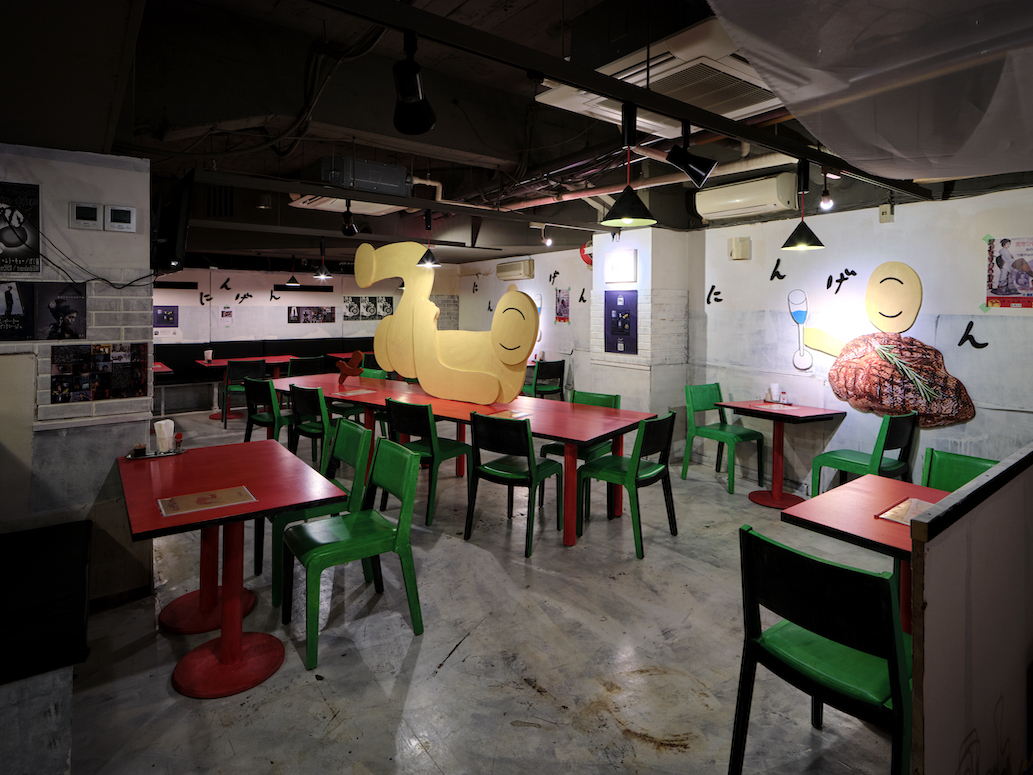
にんげんレストランNingen Restaurant
撮影:森田兼次Photo: Kenji Morita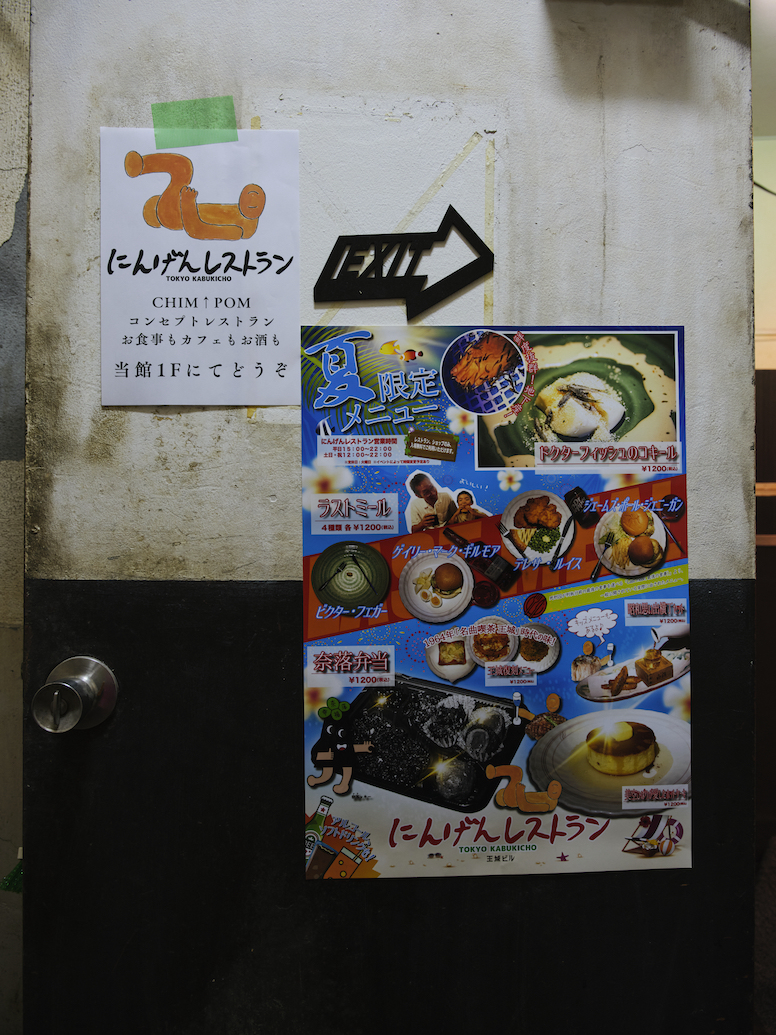
にんげんレストランNingen Restaurant
撮影:森田兼次Photo: Kenji Morita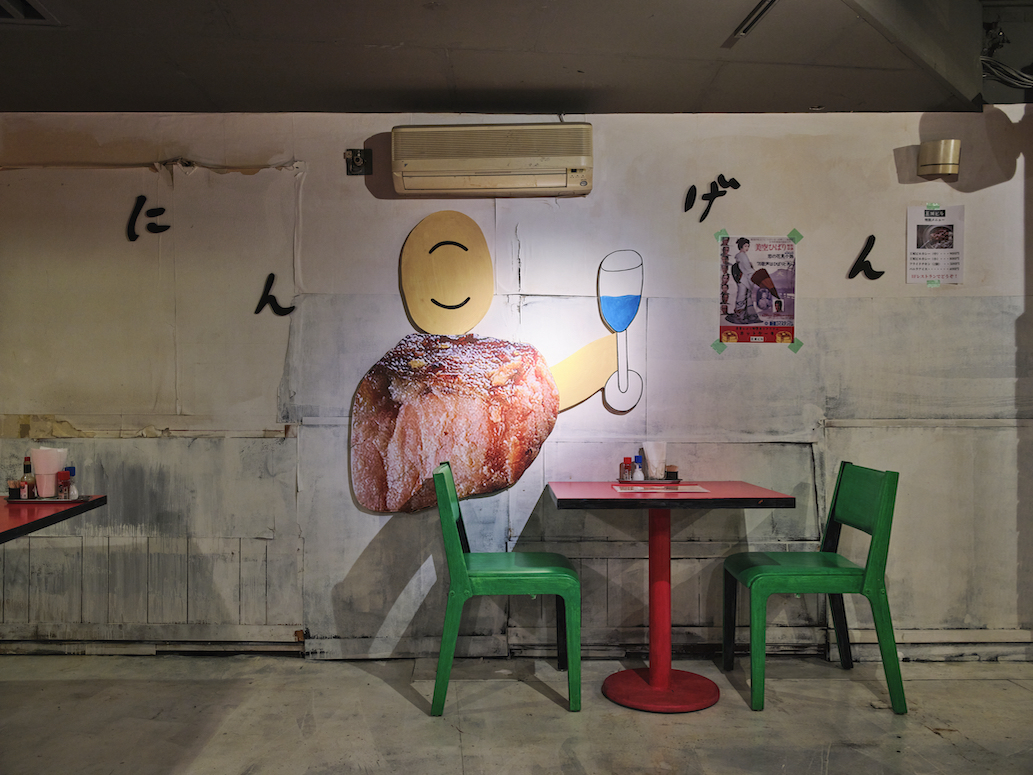
にんげんレストランNingen Restaurant
撮影:森田兼次Photo: Kenji Morita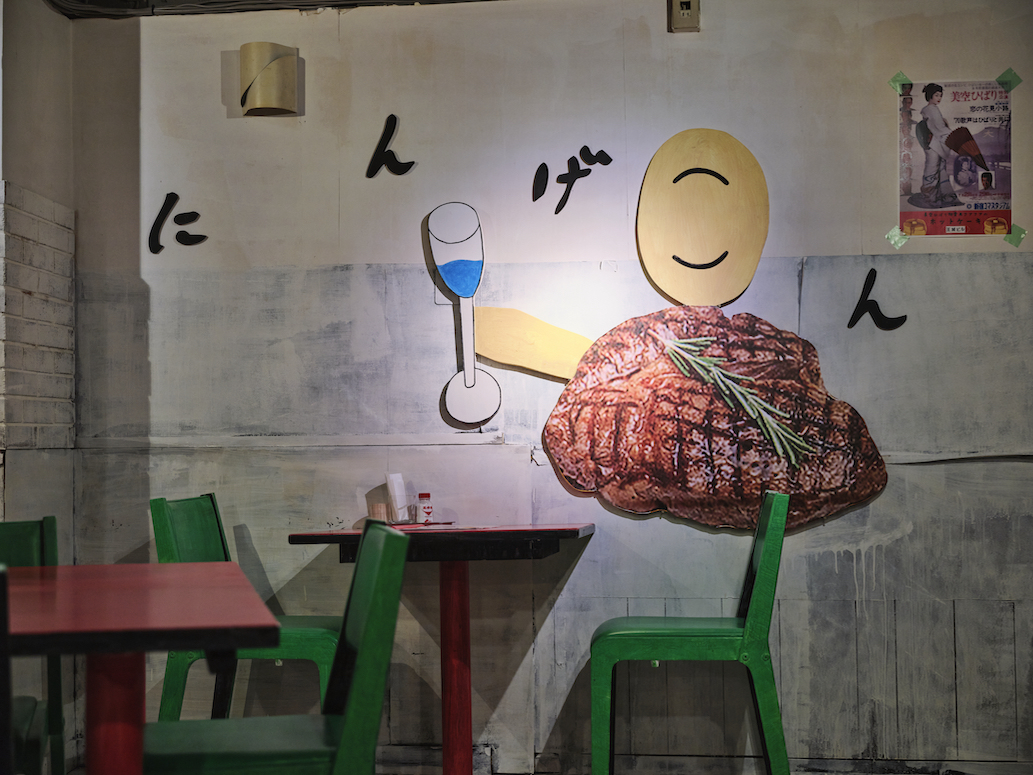
にんげんレストランNingen Restaurant
撮影:森田兼次Photo: Kenji Morita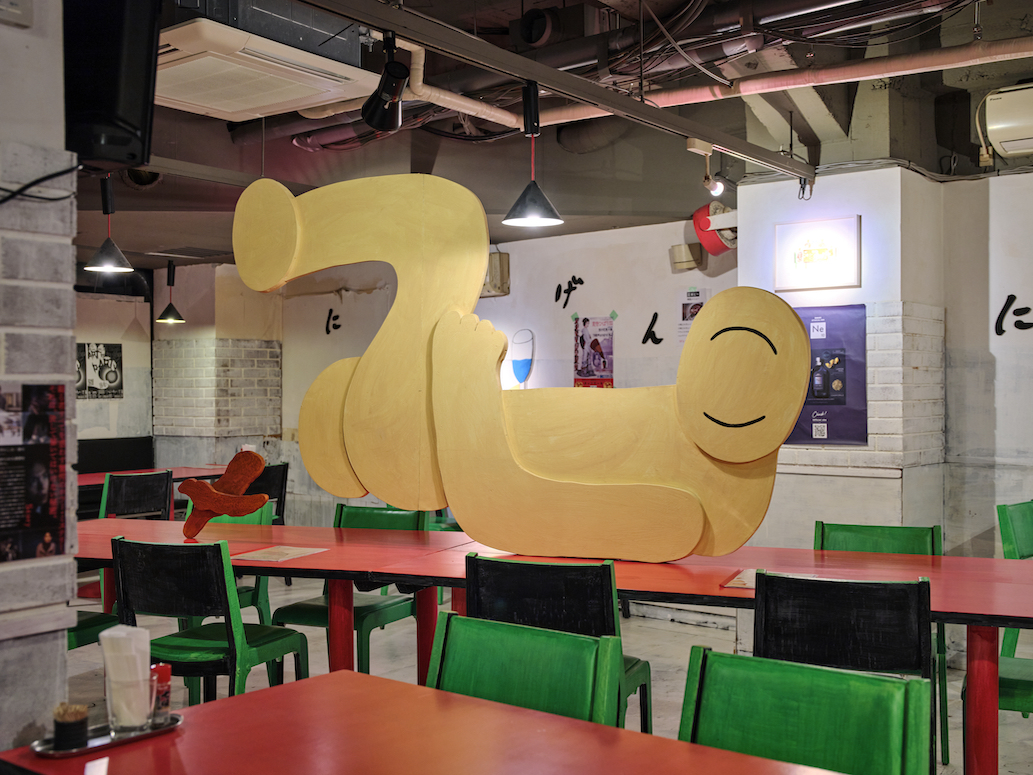
にんげんレストランNingen Restaurant
撮影:森田兼次Photo: Kenji Morita
11. 金三昧
Chim↑Pomが2014から続けるショッププロジェクト「金三昧」のポップアップ。高円寺キタコレビル、秋葉原3331、六本木の森美術館、渋谷パルコなどを巡回し、今回はミュージアムショップとして王城ビルに開店。通常高額で取引きされる作品と市場に値段が決定される商品の境界線を探り、経済的価値と無価値の間を行き来する。
11. KANE-ZANMAI
A pop-up store of KANE-ZANMAI, a shop project that Chim↑Pom has continued to execute since 2014. Previous ones were opened at Kitakore Building in Koenji, Akihabara 3331, Mori Art Museum in Roppongi, and Shibuya Parco. This time, it is being opened as a museum shop in Ohjo Building. The shop probes the boundary between works ordinarily traded at high prices and merchandise whose prices are determined by the market, and oscillates between economic value and worthlessness.
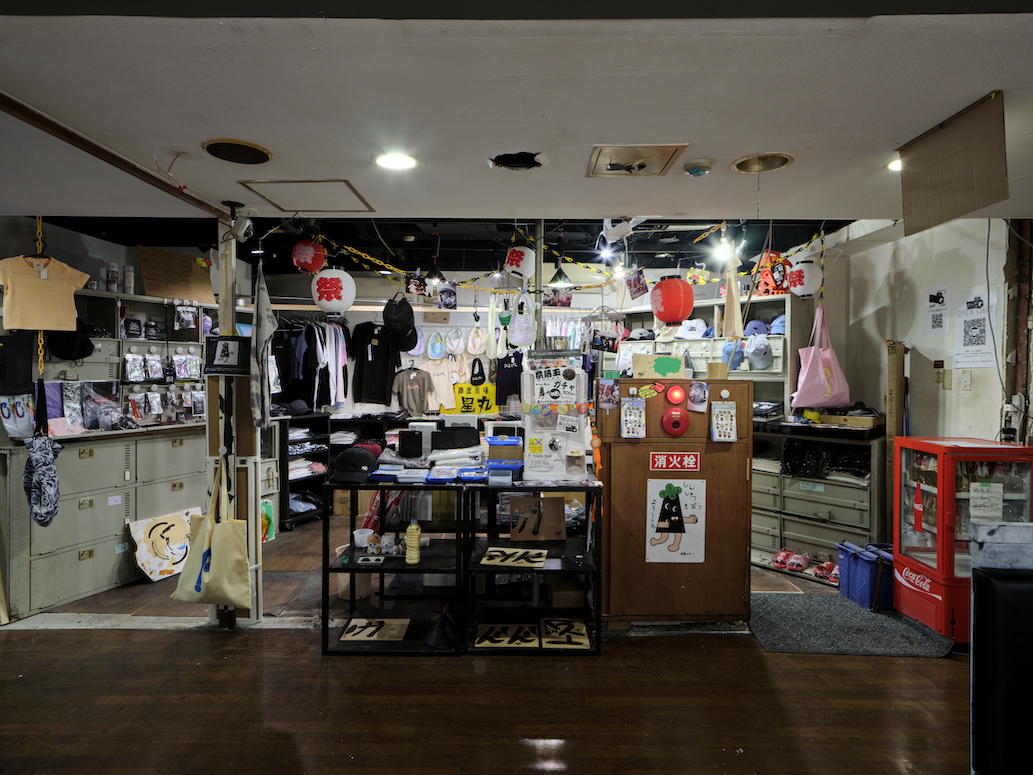
金三昧KANE-ZANMAI
撮影:森田兼次Photo: Kenji Morita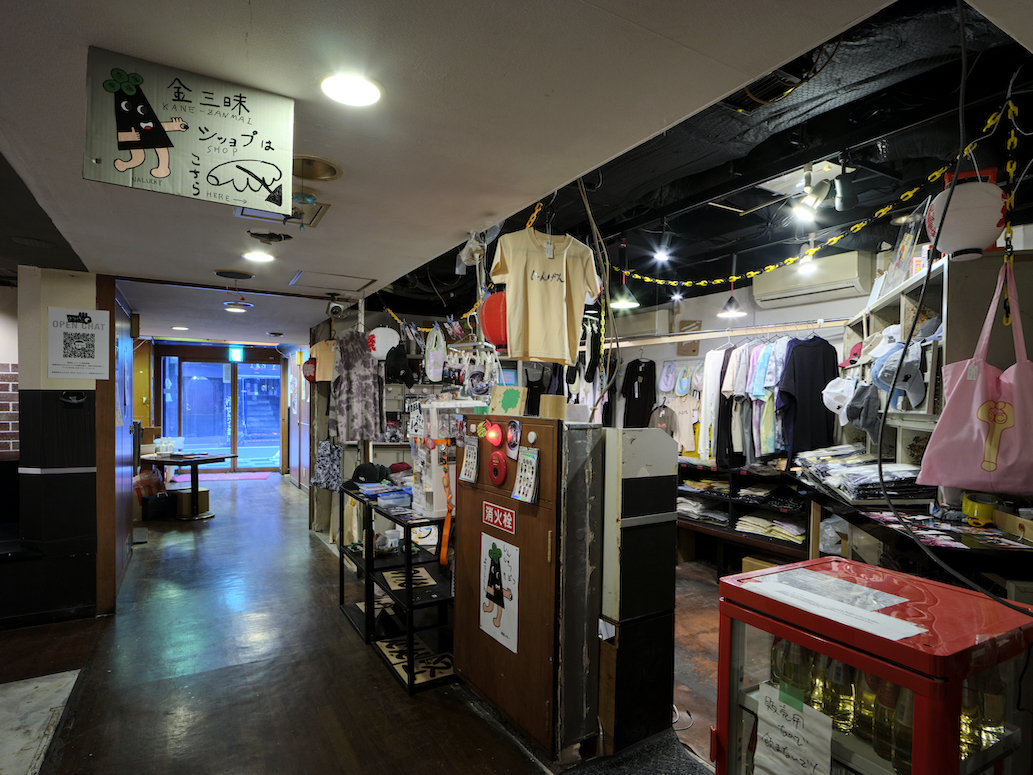
金三昧KANE-ZANMAI
撮影:森田兼次Photo: Kenji Morita
キッズルーム
Produced by 元気キッズ
Kids room
Produced by Genki Kids
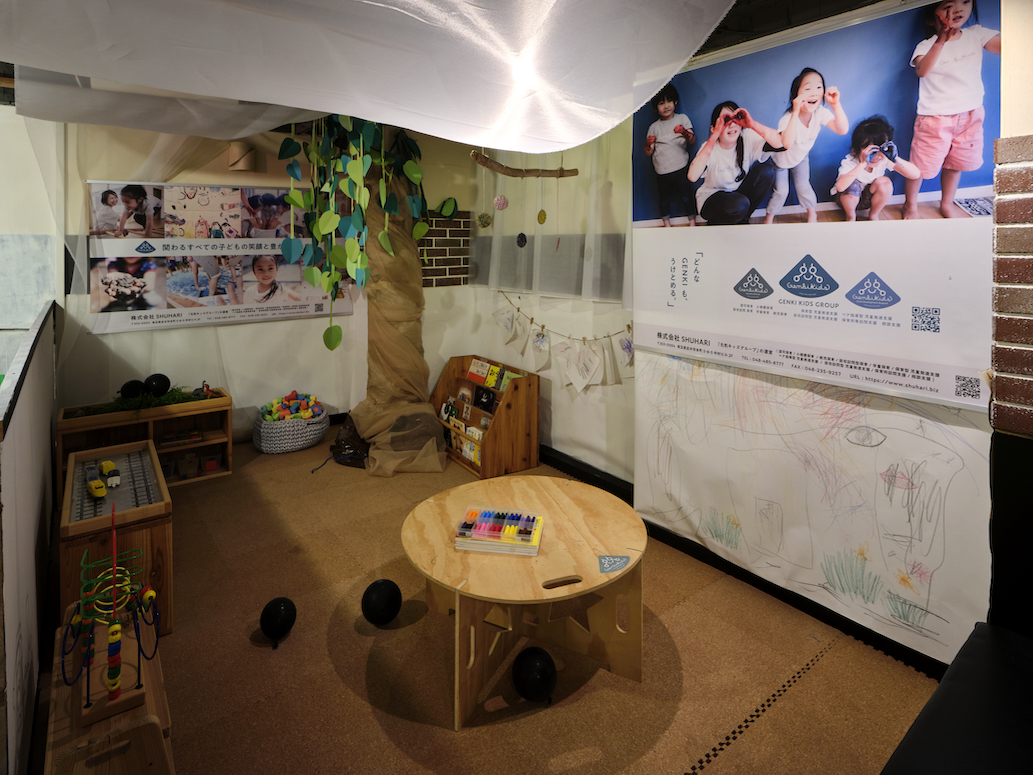
キッズルームKids room
撮影:森田兼次Photo: Kenji Morita

